The Daily Shot: 02-Dec-21
• Equities
• Credit
• Rates
• Commodities
• Energy
• Cryptocurrency
• Emerging Markets
• China
• Asia – Pacific
• Japan
• The Eurozone
• Europe
• The United Kingdom
• Canada
• The United States
• Global Developments
• Food for Thought
Equities
1. The first omicron case in the US spooked investors,…
 Source: AP Read full article
Source: AP Read full article
… sending the S&P 500 below its 50-day moving average.
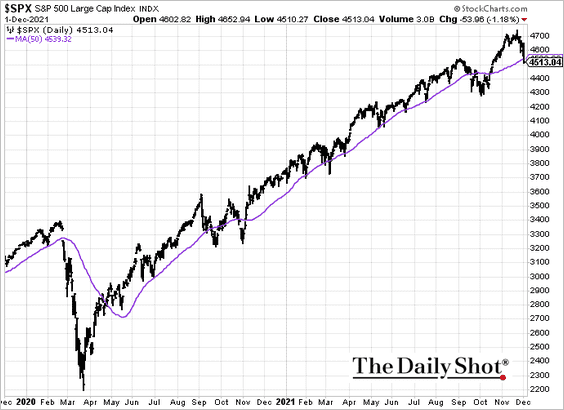
• Major US indices have diverged, with the Dow slumping by over 5% in recent weeks.
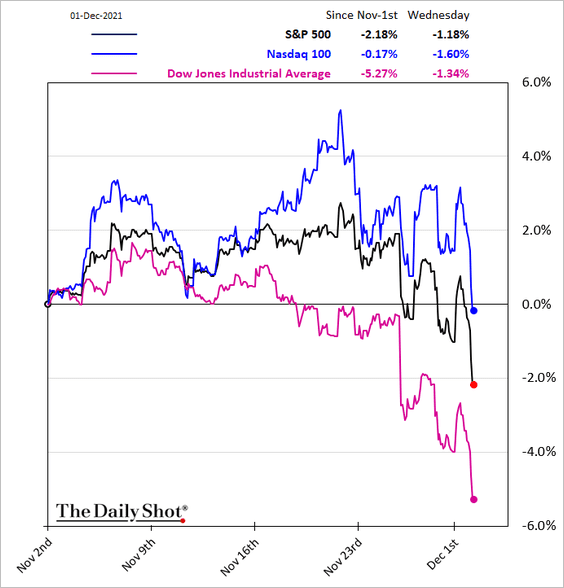
• The share of NYSE stocks closing above their 200-day moving average dipped below 50%.

• The selloff has been broad. This chart shows the number of stocks hitting 52-week highs vs. those at 52-week lows.
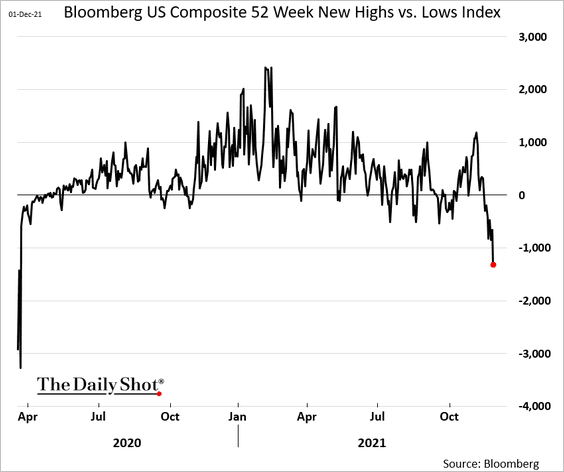 h/t Cormac Mullen
h/t Cormac Mullen
• The median stock price has sharply underperformed the S&P 500.
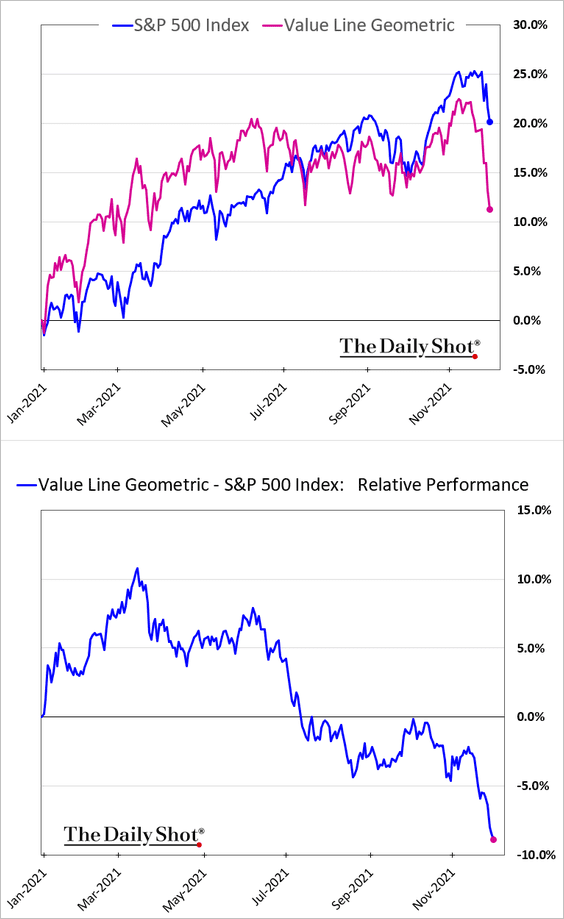
——————–
2. Funds have been dumping the most expensive tech shares.
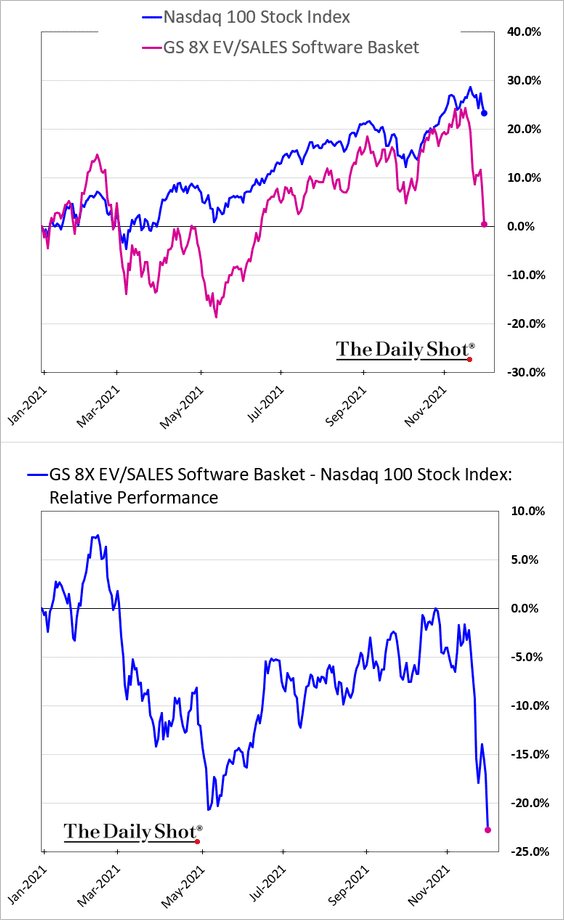 Further reading
Further reading
High-multiple stocks are vulnerable to real rates, which have been rising.
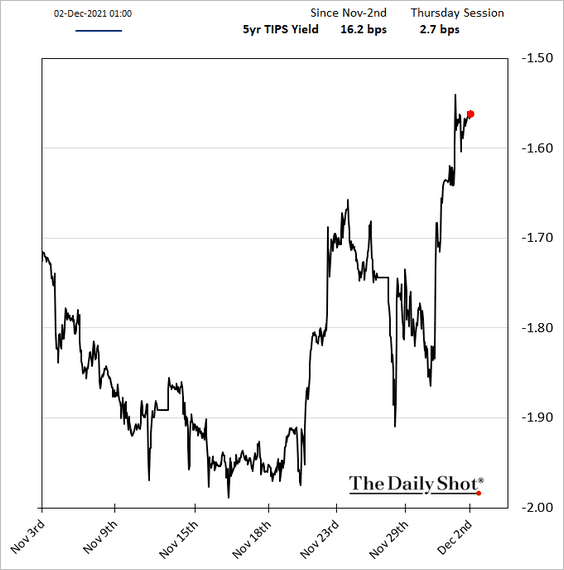
——————–
3. Momentum stocks continue to underperform.
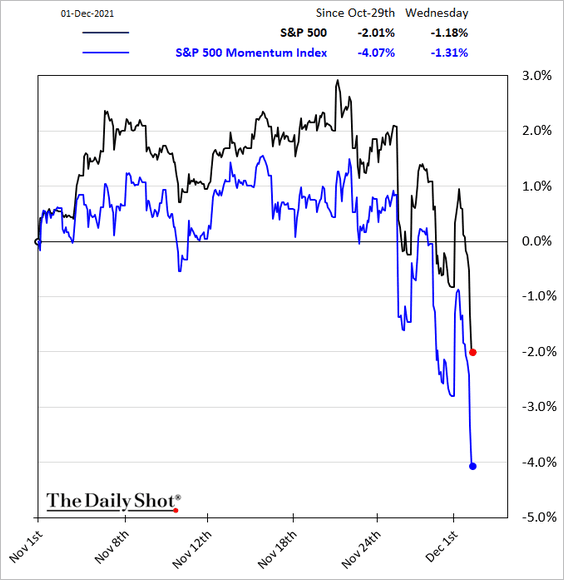
4. Small caps are down sharply, with microcaps now in correction territory.
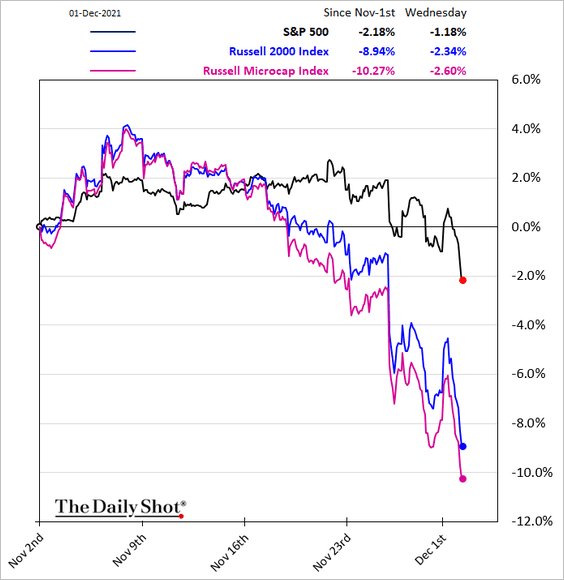
The Russell 2000 index is back at the low end of its trading range.
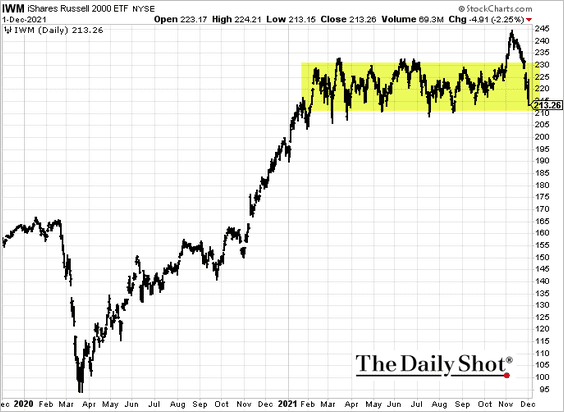
——————–
5. Next, we have some sector performance charts (over the past month).
• November returns:
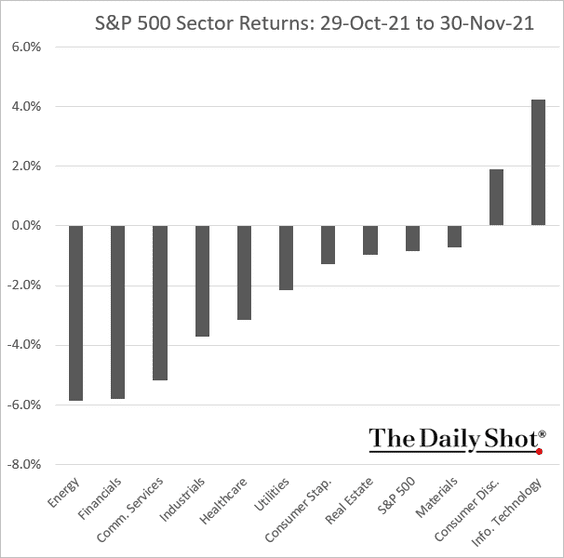
• Tech and semiconductors:
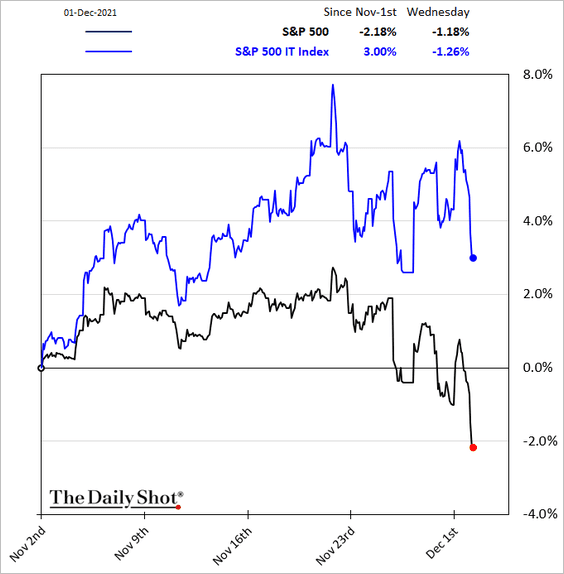
![]()
• Communication Services:
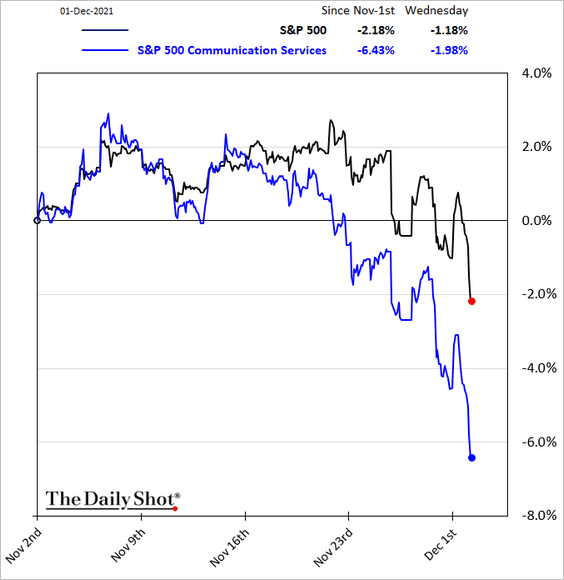
• Banks:

• Industrials:
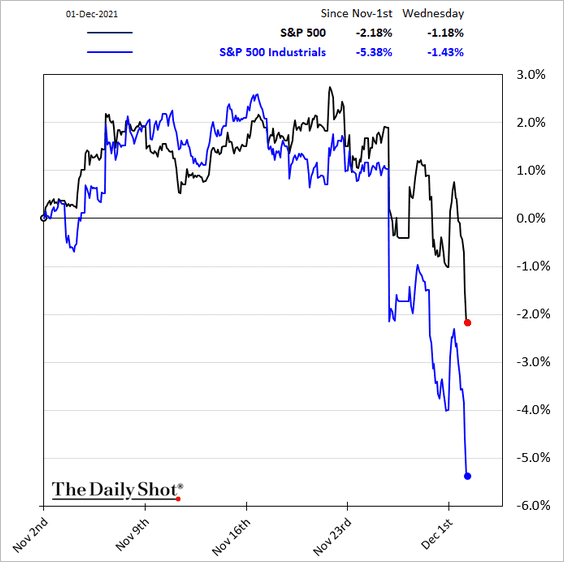
• Transportation:
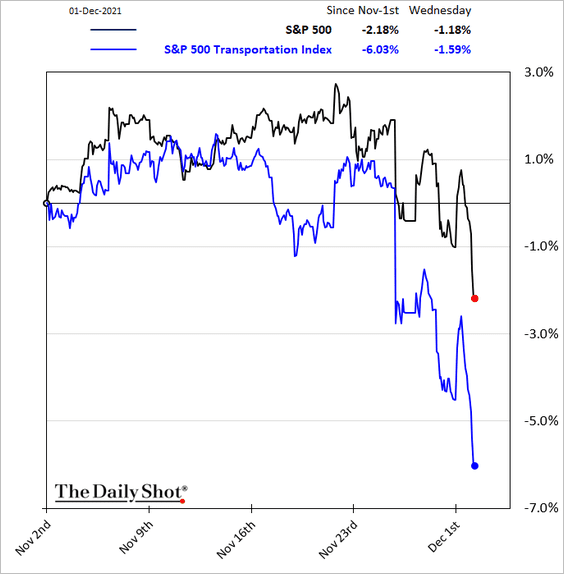
• Separately, here is the size and breadth of earning beats by sector.
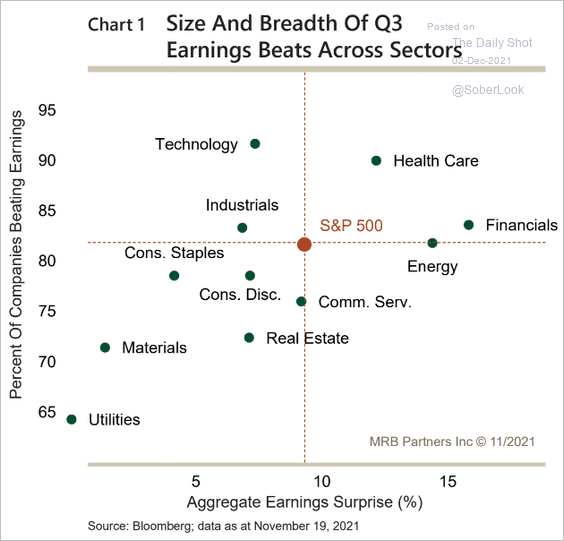 Source: MRB Partners
Source: MRB Partners
——————–
6. The percentage of bearish investors hit the highest level in over a year, according to AAII.
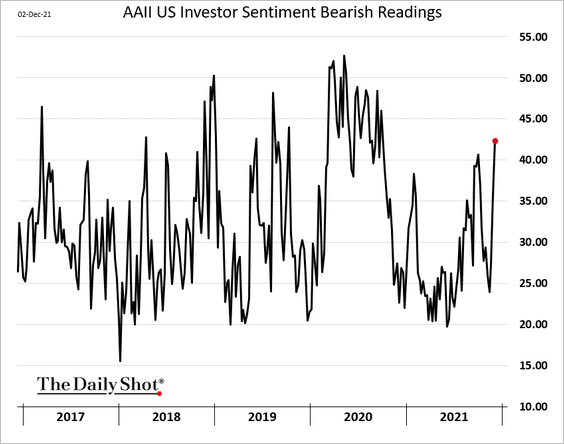
7. VIX climbed above 30 …
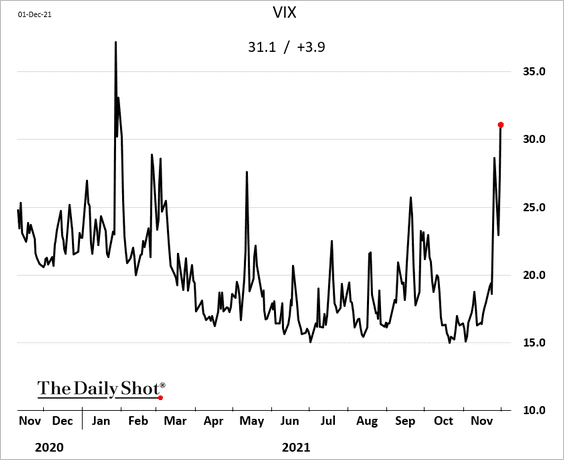
… and the vol curve shifted into backwardation (inverted).
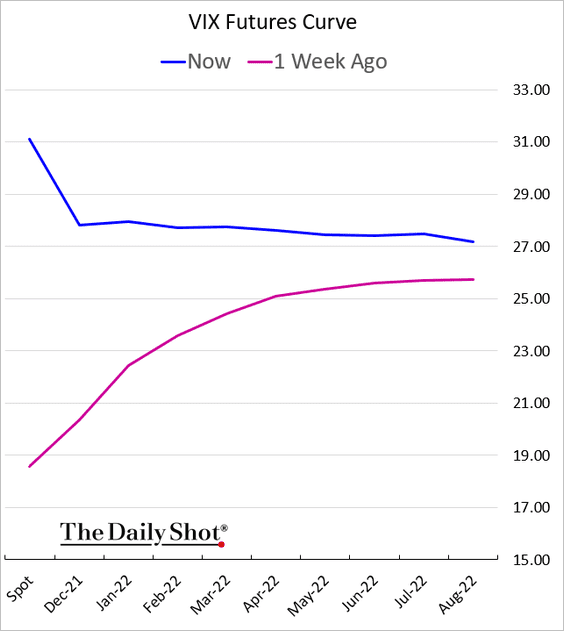
——————–
8. The volume of traditional IPOs hit a record this year in dollar terms.
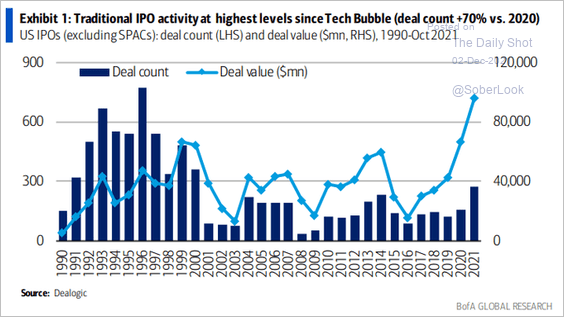 Source: BofA Global Research; @MikeZaccardi
Source: BofA Global Research; @MikeZaccardi
But here is the IPO deal value relative to the US market cap (with and without SPACs).
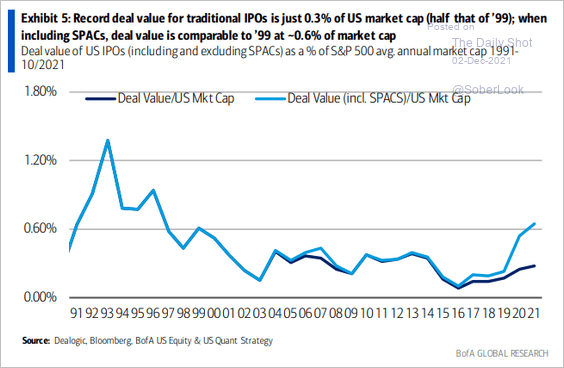 Source: BofA Global Research; @MikeZaccardi
Source: BofA Global Research; @MikeZaccardi
Back to Index
Credit
The spread on Bloomberg’s investment-grade bond index is back above 1%.
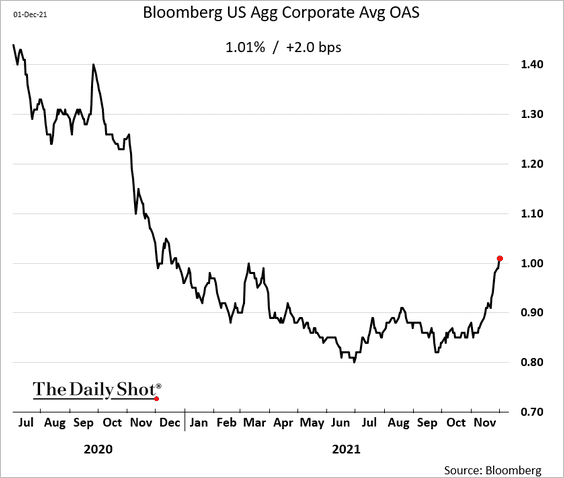
Back to Index
Rates
1. Here is the attribution of changes in Treasury yields.
• November:
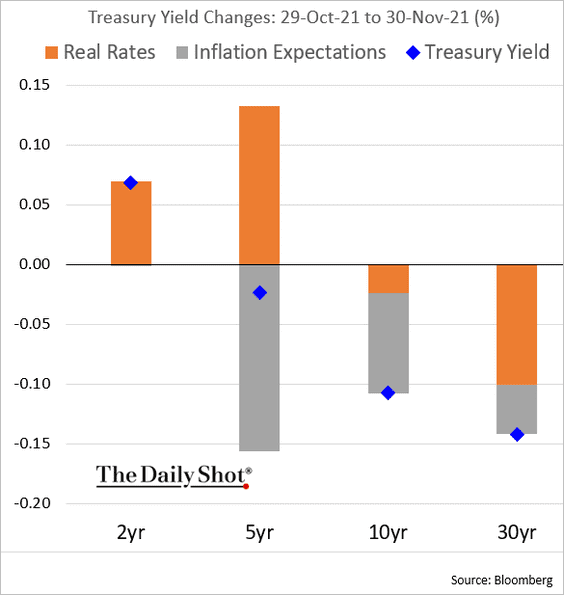
• Year-to-date:
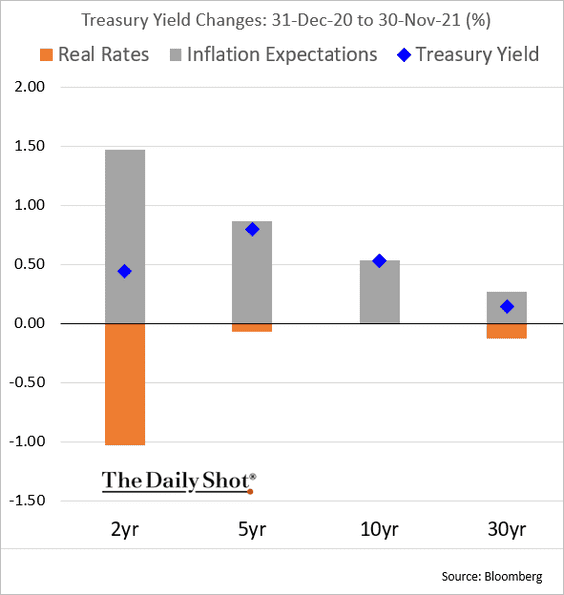
——————–
2. Speculative accounts are betting on further flattening in the 10yr – 30yr part of the curve.
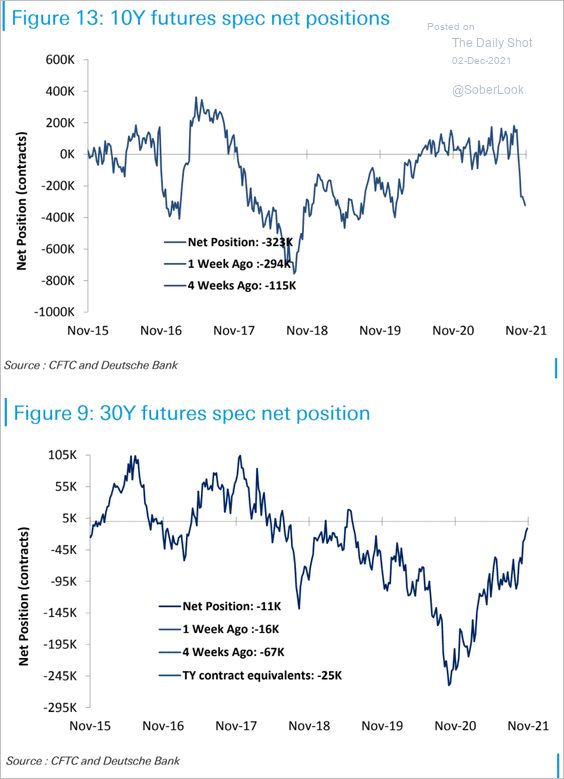 Source: Deutsche Bank Research
Source: Deutsche Bank Research
Back to Index
Commodities
1. US lumber futures are rebounding.
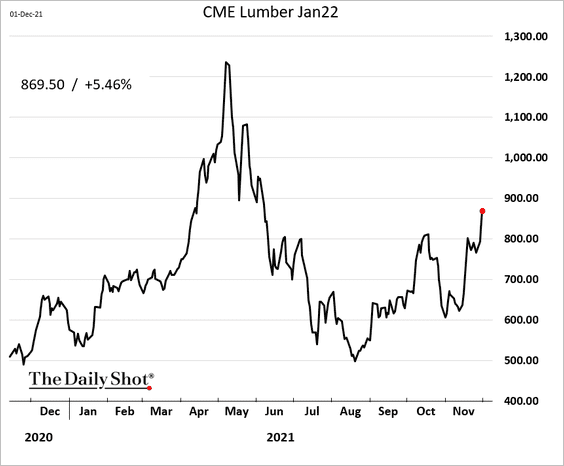
 Source: North Bay Business Journal Read full article
Source: North Bay Business Journal Read full article
——————–
2. Materials stocks have been underperforming despite higher commodity prices.
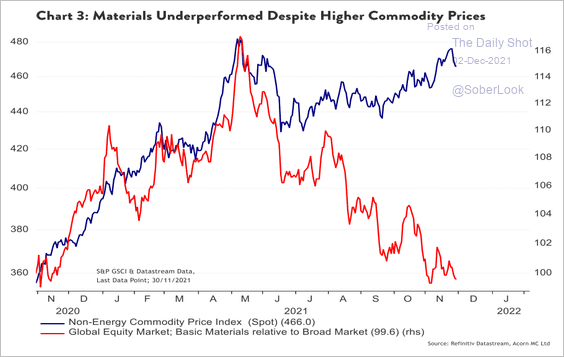 Source: Acorn Macro Consulting Ltd.
Source: Acorn Macro Consulting Ltd.
Back to Index
Energy
1. Brent is testing support at $70/bbl.
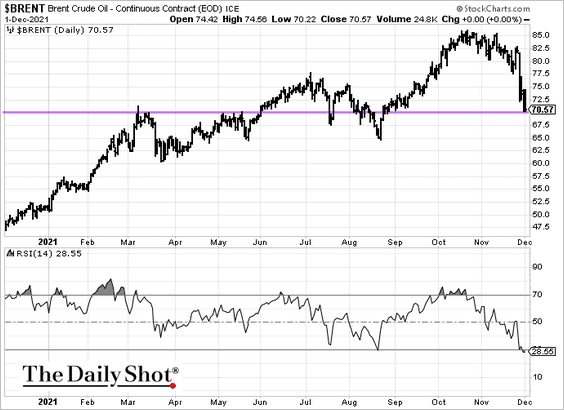
2. US crude oil production hit the highest level since the spring of 2020.
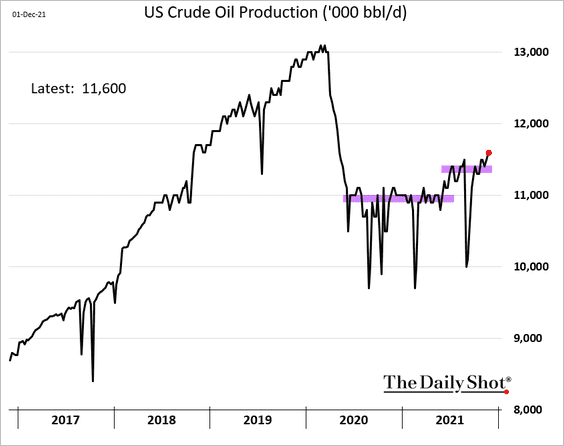
3. US oil inventories are well below the 5-year range.
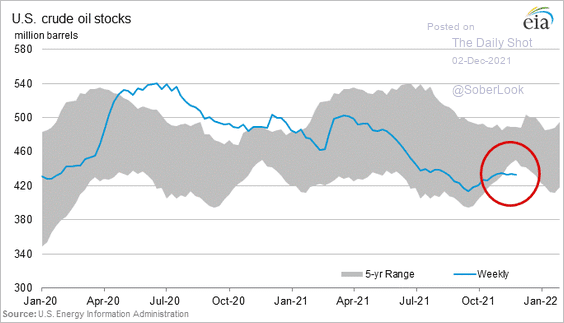
4. Gasoline demand has softened in recent weeks.
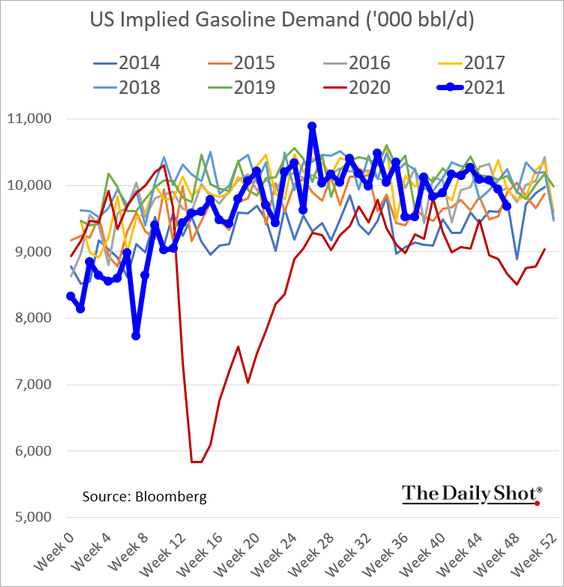
Refinery runs remain weak for this time of the year.
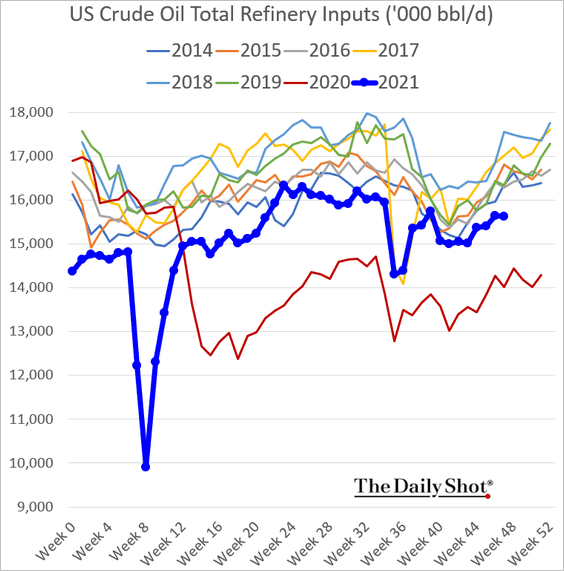
——————–
5. This chart shows the drivers of crude oil demand deviation from the pre-COVID path.
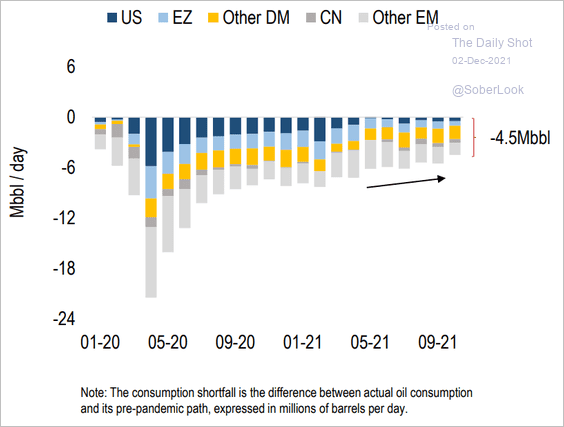 Source: Numera Analytics
Source: Numera Analytics
6. US natural gas futures continue to slump.
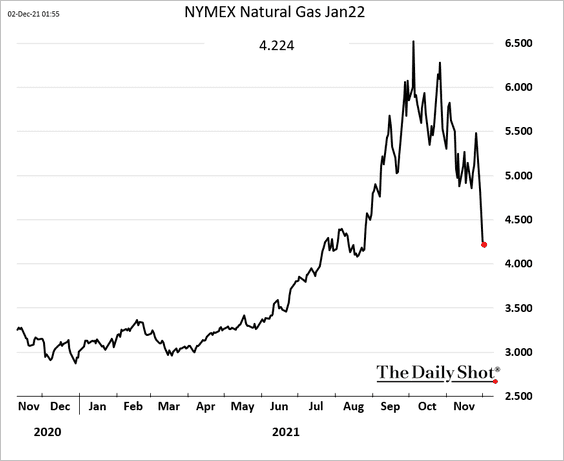
Back to Index
Cryptocurrency
1. Bitcoin remains range-bound in the lower end of its Bollinger Band.
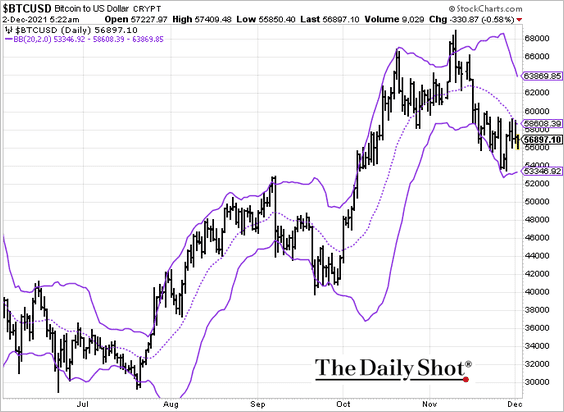
2. Litecoin (LTC) and ether (ETH) outperformed other large cryptocurrencies in November.
 Source: CoinDesk Read full article
Source: CoinDesk Read full article
3. Typically, bitcoin has positive returns in the fourth quarter. Will we see a strong December before a January decline?
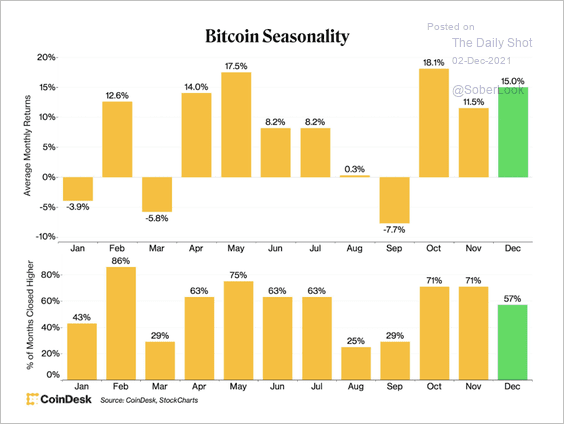 Source: CoinDesk Read full article
Source: CoinDesk Read full article
4. Open interest in bitcoin’s futures market remains high despite last week’s sell-off.
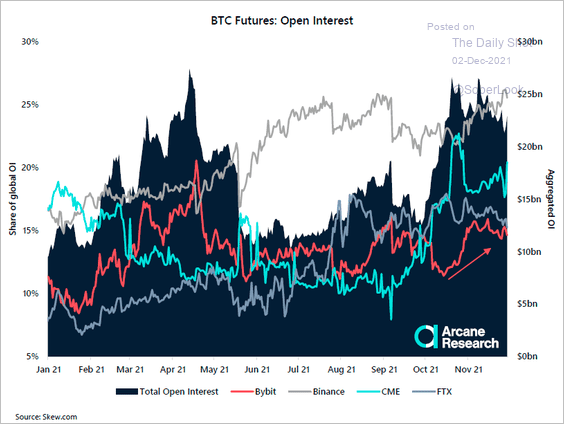 Source: @ArcaneResearch
Source: @ArcaneResearch
5. Bitcoin’s Fear & Greed Index is at the lowest level since late September, which preceded a price recovery.
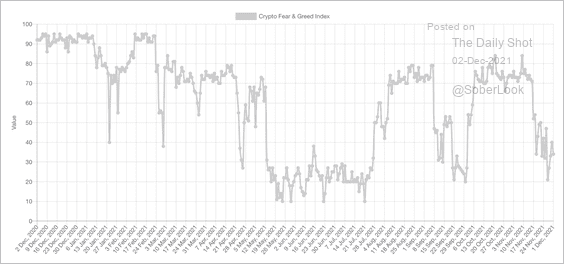 Source: Alternative.me
Source: Alternative.me
Back to Index
Emerging Markets
1. Chile’s economy continues to surge ahead despite the politics.
• Economic activity:
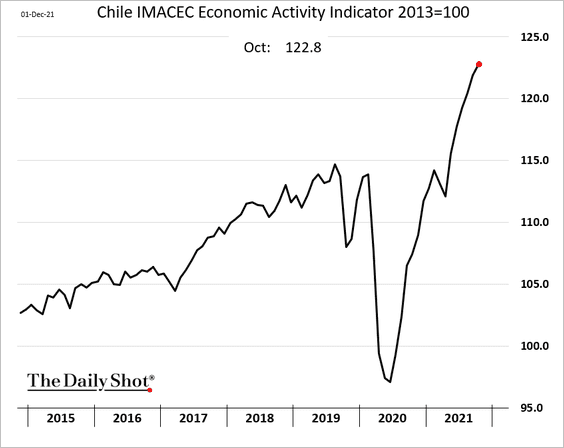
• Manufacturing output:
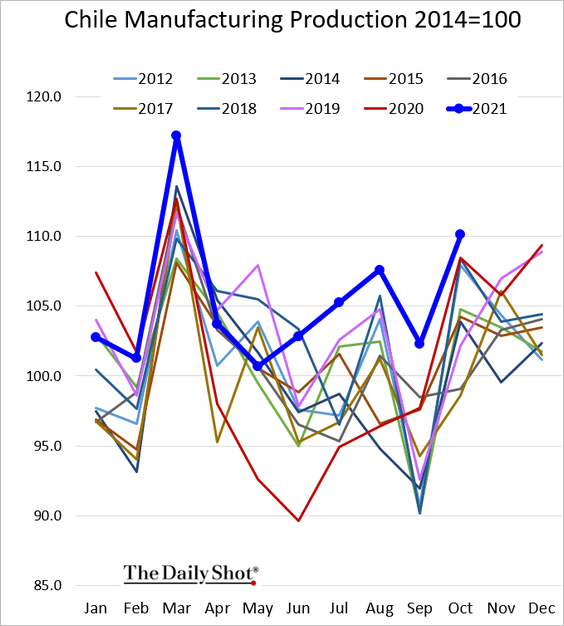
• Copper output (rebounding):
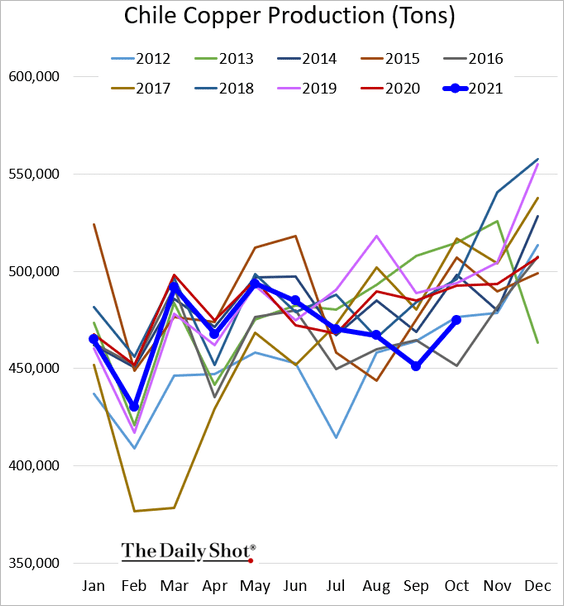
• Retail sales:
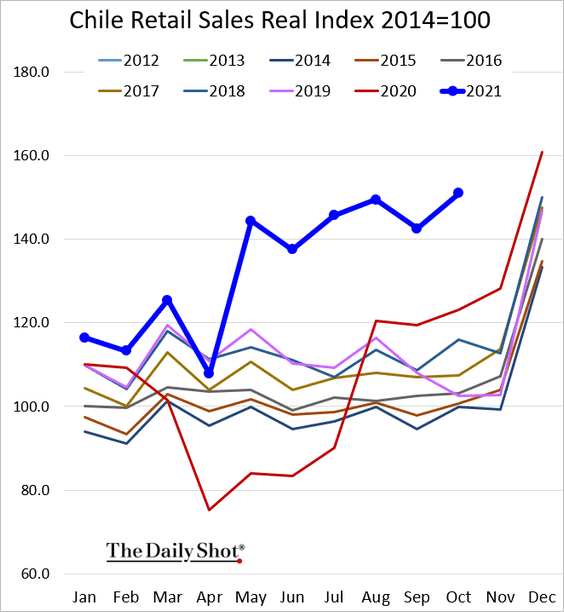
• The unemployment rate:
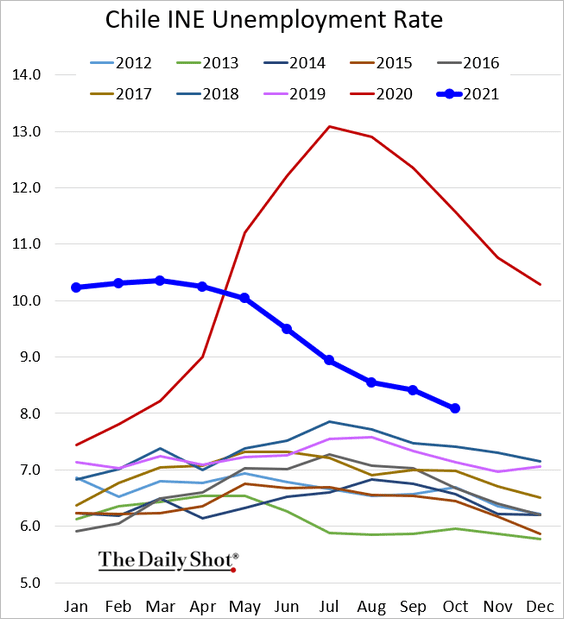
——————–
2. Colombia’s factory activity remains robust.
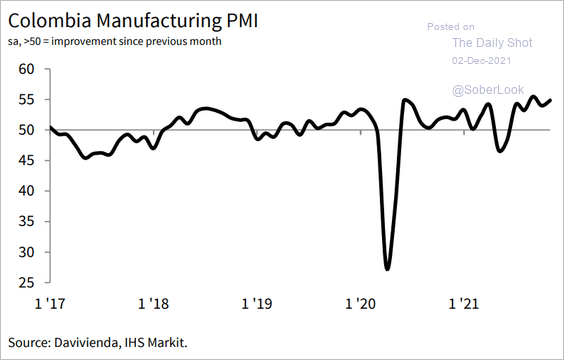 Source: IHS Markit
Source: IHS Markit
However, Columbia’s bond risk premium is at the highest level since the first wave of the pandemic.
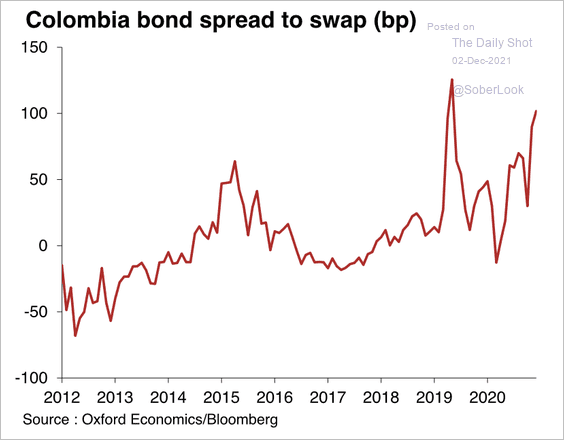 Source: Oxford Economics
Source: Oxford Economics
——————–
3. Next, we have some updates on Brazil.
• Manufacturing activity (now in contraction territory):
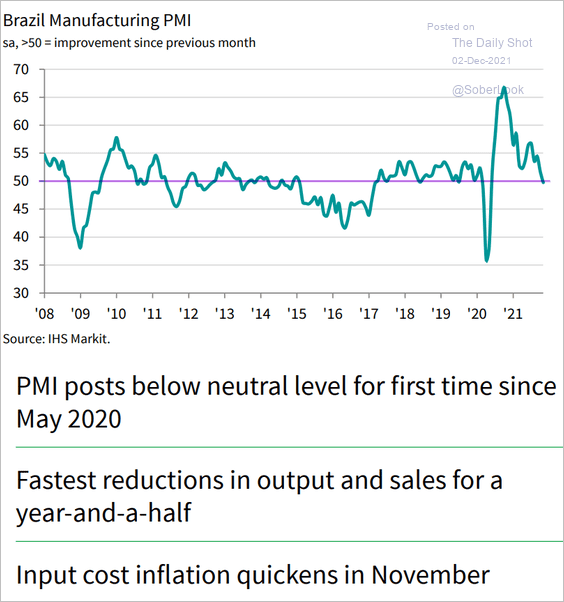 Source: IHS Markit
Source: IHS Markit
• The debt-to-GDP ratio:
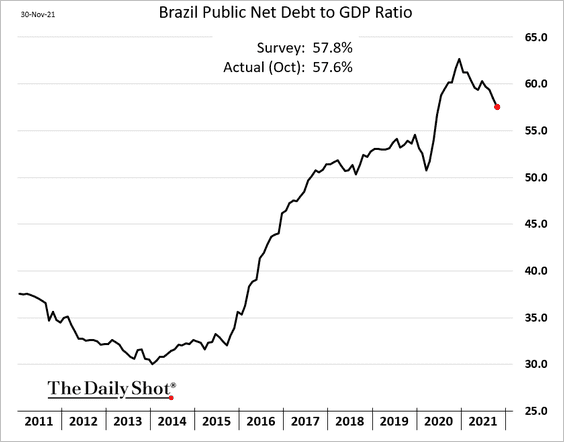
• Bond spreads (low despite potential fiscal deterioration and recent economic weakness):
 Source: Oxford Economics
Source: Oxford Economics
• Formal job creation:
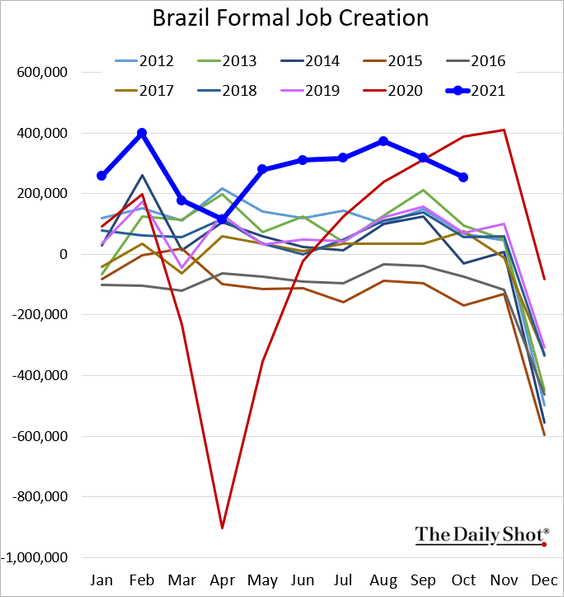
——————–
4. Mexico’s manufacturing sector can’t quite shift into growth mode, partially due to weak vehicle production.
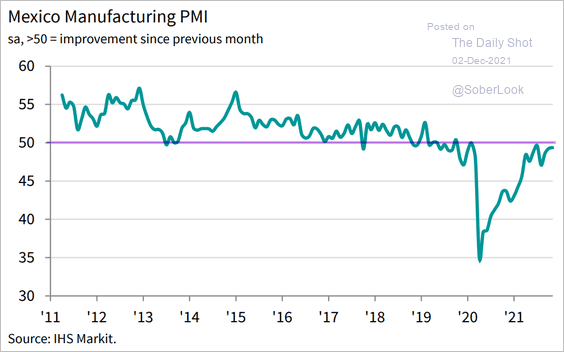 Source: IHS Markit
Source: IHS Markit
Remittances hit a record high.

——————–
5. By the way, sending people to wealthy countries (legally or illegally) is a massive source of capital inflows for many EM economies. There is no incentive for governments to “stem” the flow of migrants.
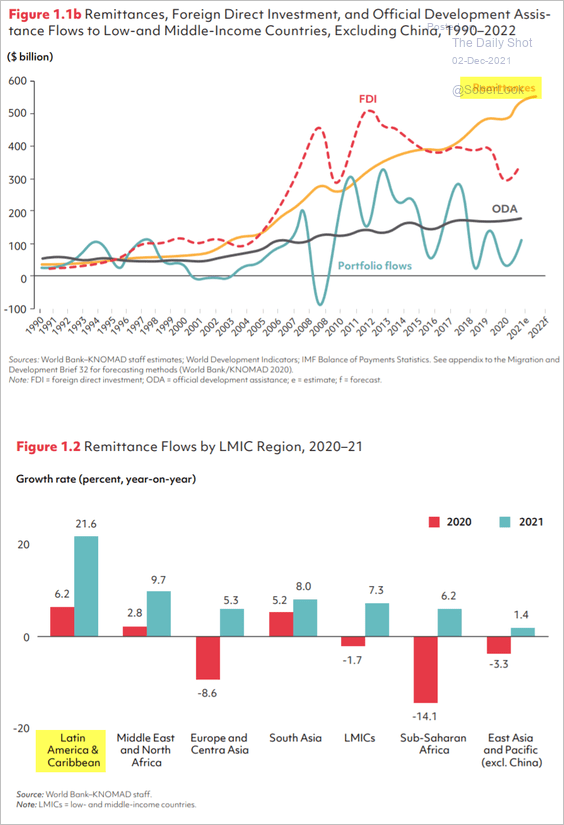 Source: Knomad Read full article
Source: Knomad Read full article
6. Next, let’s take a look at some trends in Russia which point to stronger economic activity.
• Cargo shipments:
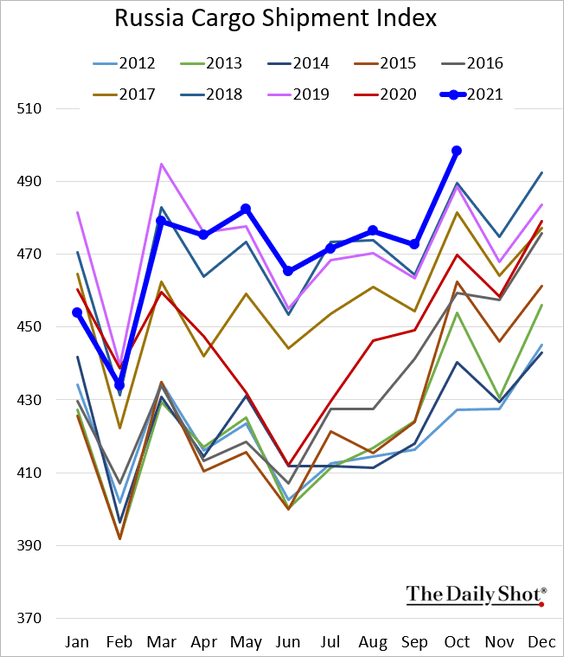
• Construction:
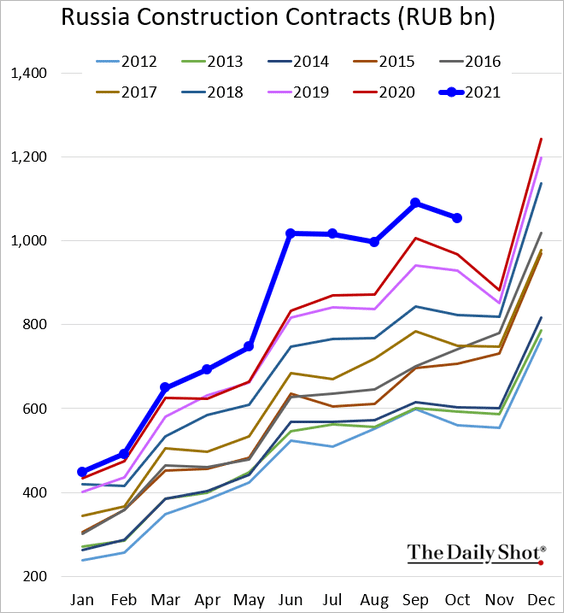
• Retail sales (holding above 2019 levels despite high inflation):
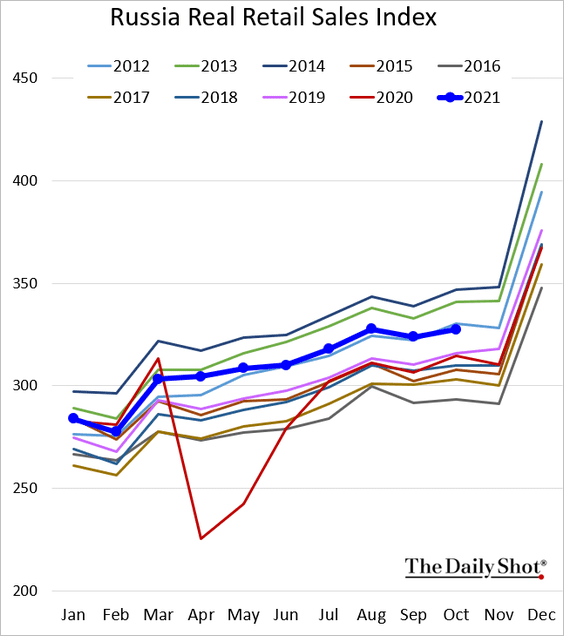
• The unemployment rate:
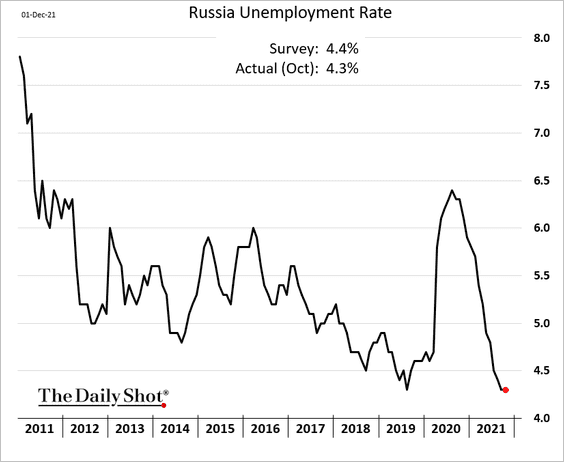
——————–
7. South Africa’s manufacturing PMI topped economists’ forecasts.
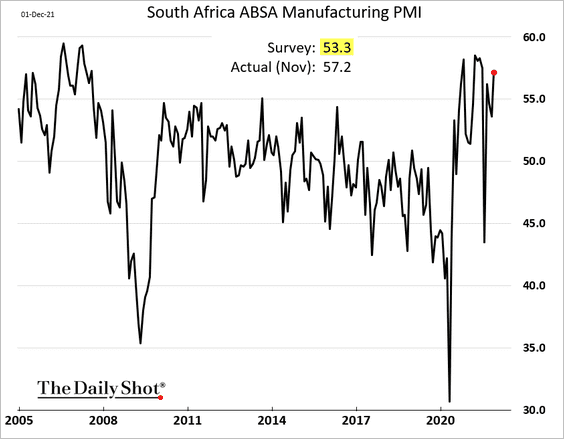
However, over a third of the workforce is now “officially” unemployed.
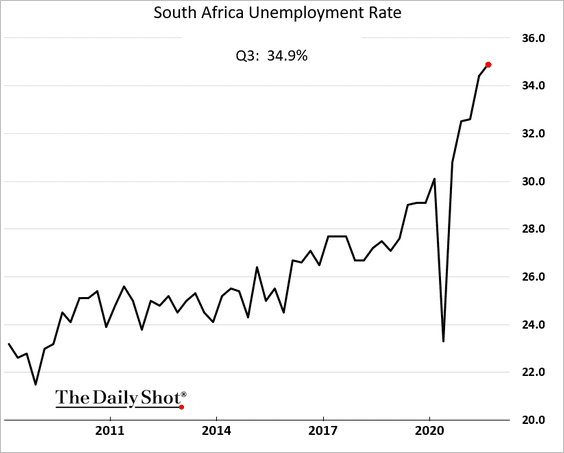
——————–
8. Turkey intervened in the F/X market, halting the lira’s crash.
 Source: @financialtimes Read full article
Source: @financialtimes Read full article
But then, the finance minister got replaced, …
 Source: @financialtimes Read full article
Source: @financialtimes Read full article
… sending the lira to new lows.
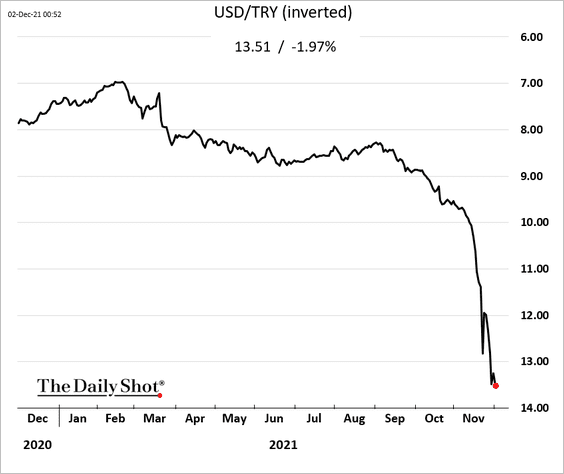
The stock market often becomes a “safe haven” in a collapsing currency regime.
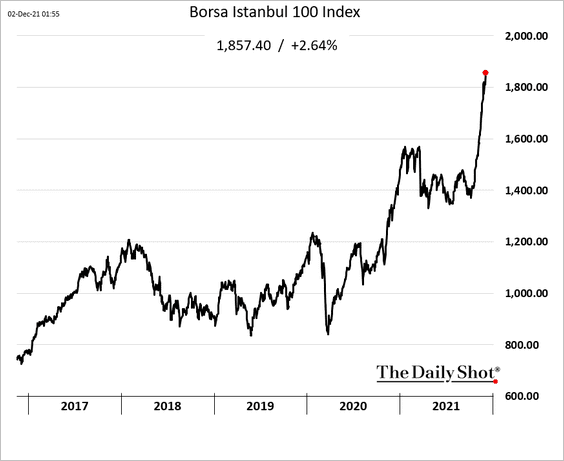
Back to Index
China
1. Stocks are testing long-term support in Hong Kong.
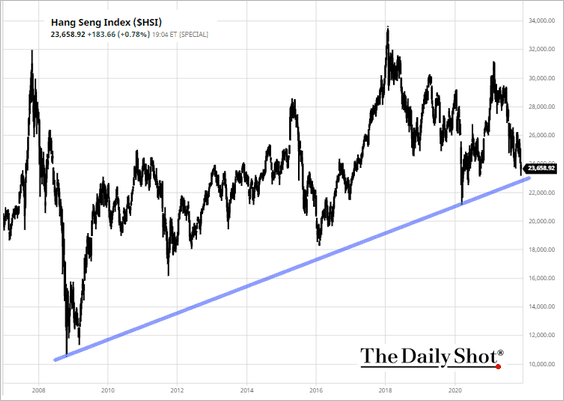 Source: barchart.com
Source: barchart.com
2. China’s government bonds have outperformed over the past decade.
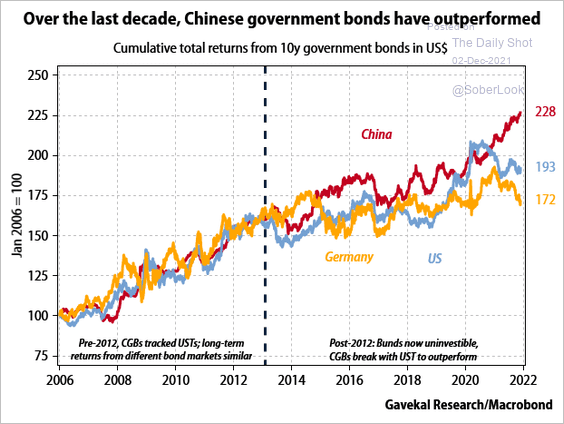 Source: Gavekal Research
Source: Gavekal Research
3. The charts below show China’s infrastructure and housing trends.
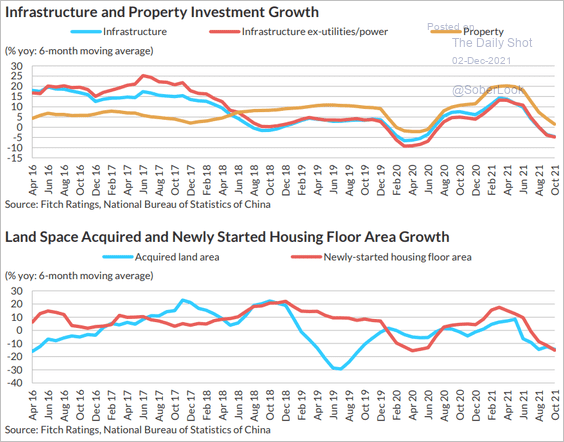 Source: Fitch Ratings
Source: Fitch Ratings
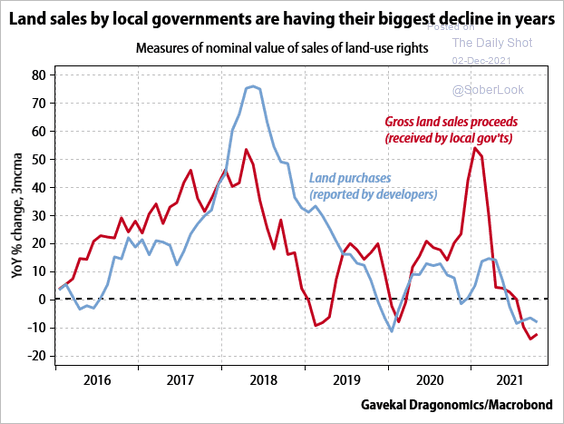 Source: Gavekal Research
Source: Gavekal Research
——————–
4. China’s marriages continue to decline.
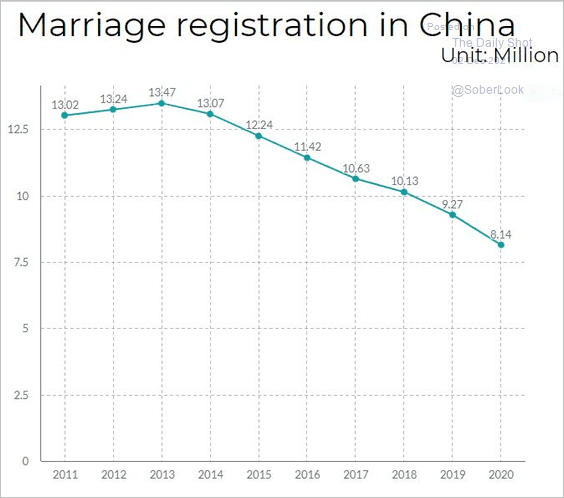 Source: @BrankoMilan Read full article
Source: @BrankoMilan Read full article
Back to Index
Asia – Pacific
1. South Korea’s CPI surprised to the upside, pointing to more rate hikes ahead.
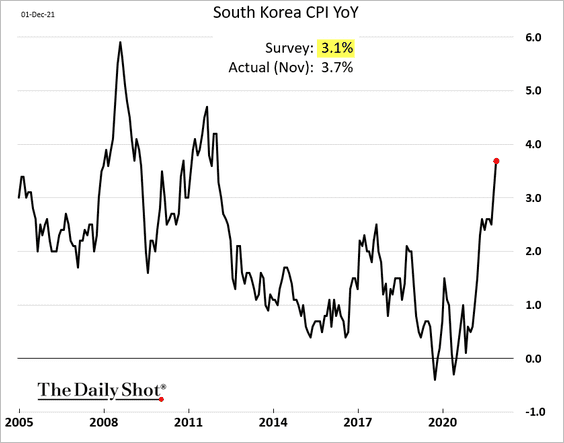
Separately, a high debt burden makes South Korea especially sensitive to rising interest rates.
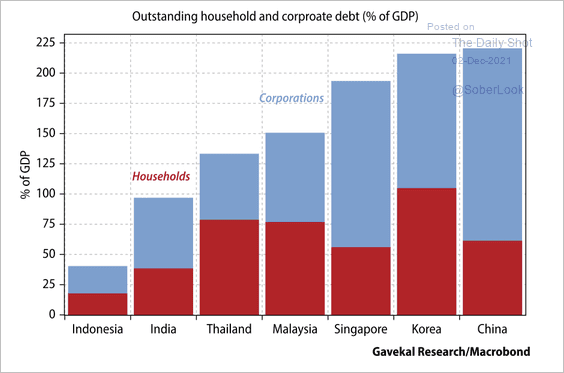 Source: Gavekal Research
Source: Gavekal Research
——————–
2. Australia’s trade surplus is off the highs but remains impressive.
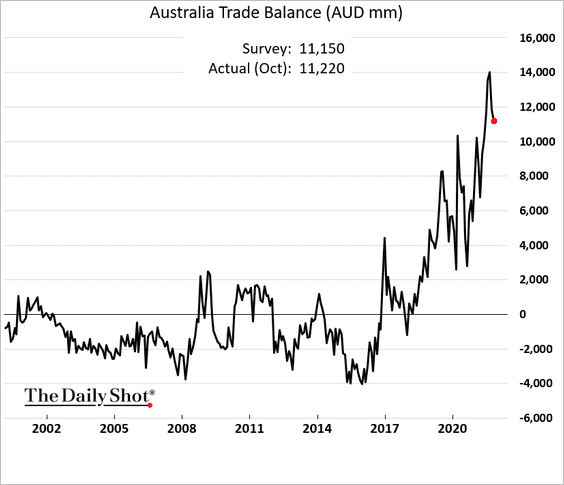
Back to Index
Japan
1. Traders have soured on Japanese equities.
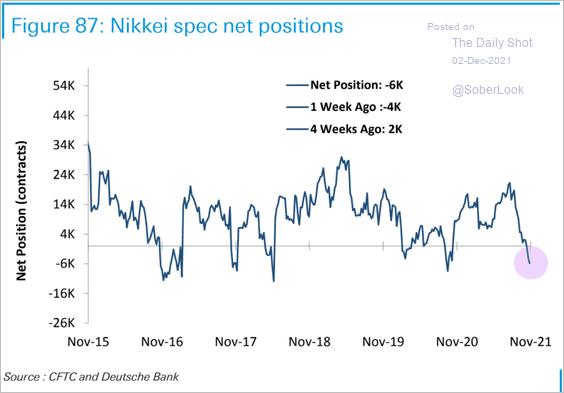 Source: Deutsche Bank Research
Source: Deutsche Bank Research
2. Consumer sentiment held up in November.
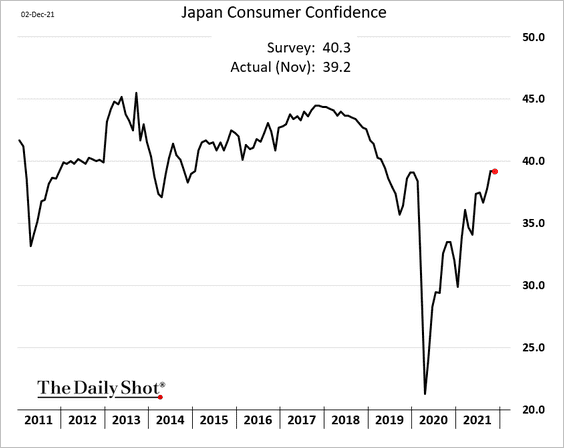
3. Vehicle sales are still soft for this time of the year.
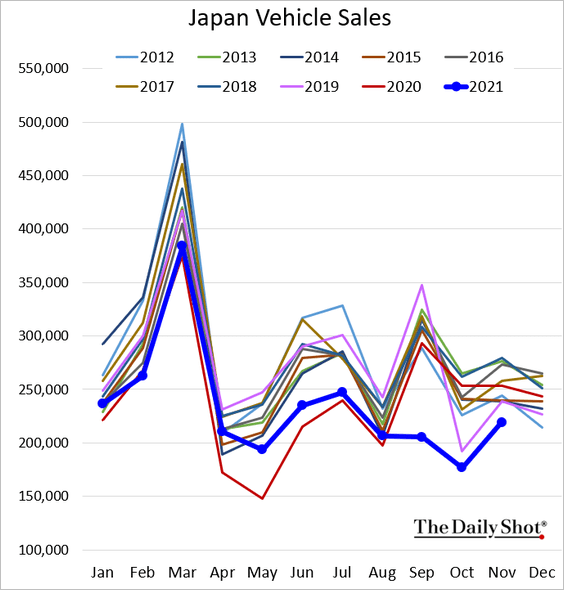
Back to Index
The Eurozone
1. Italian spreads to Germany have been widening amid increased risk aversion.
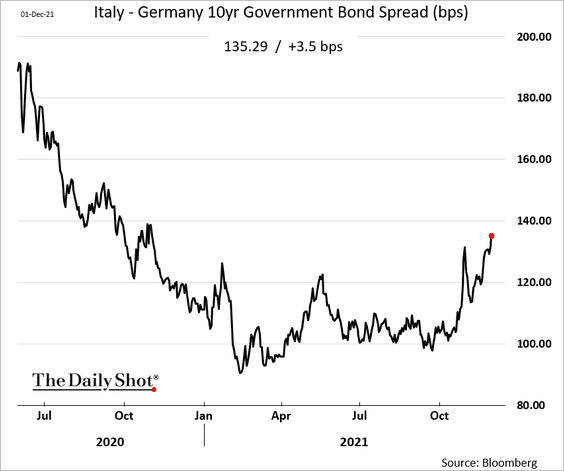
2. Italian manufacturing PMI hit a new high, as the nation’s factory sector diverges from the rest of the Eurozone.
 Source: IHS Markit
Source: IHS Markit
As a comparison, here is Germany’s PMI.
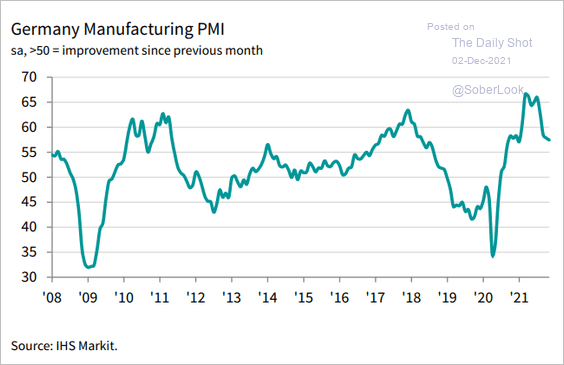 Source: IHS Markit
Source: IHS Markit
——————–
3. Germany’s retail sales were back on the pre-COVID trend in October.
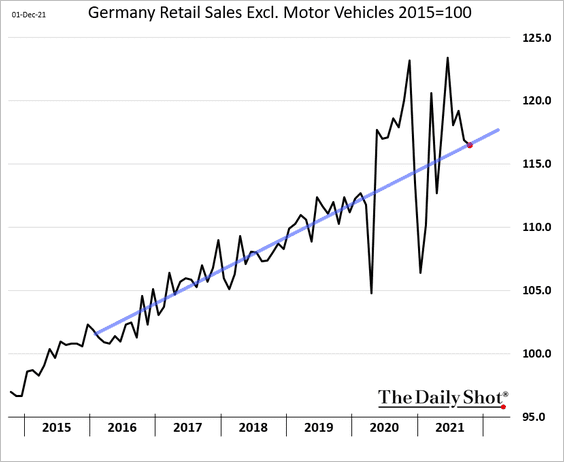
4. Euro-area deposit growth points to softer retail sales ahead.
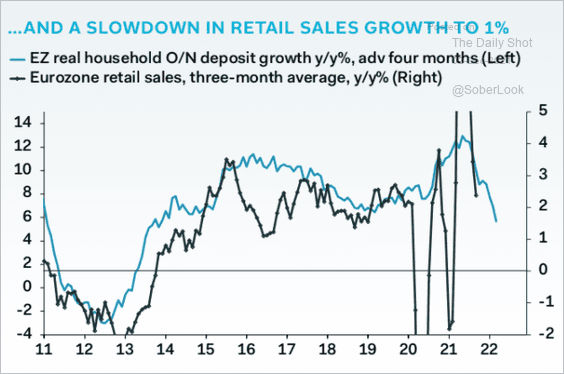 Source: Pantheon Macroeconomics
Source: Pantheon Macroeconomics
5. France is bucking the trend on labor force participation.
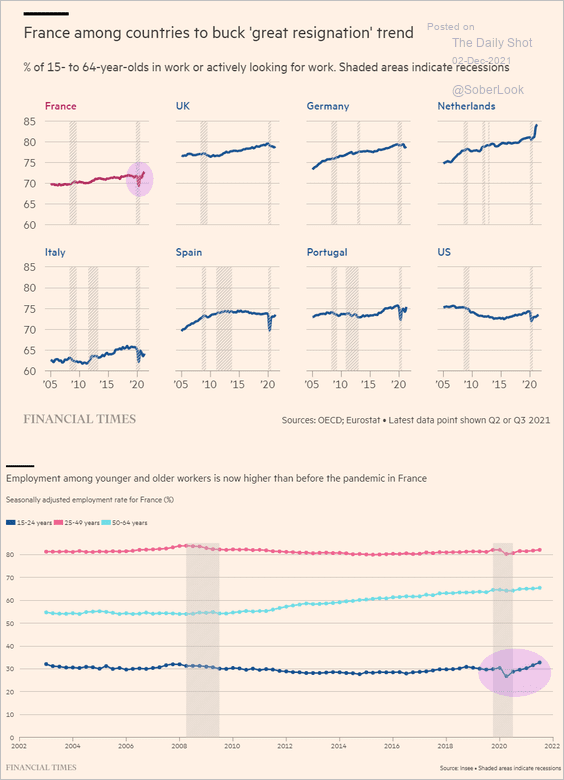 Source: @financialtimes Read full article
Source: @financialtimes Read full article
Back to Index
Europe
1. Swiss GDP growth has been outperforming the Eurozone.
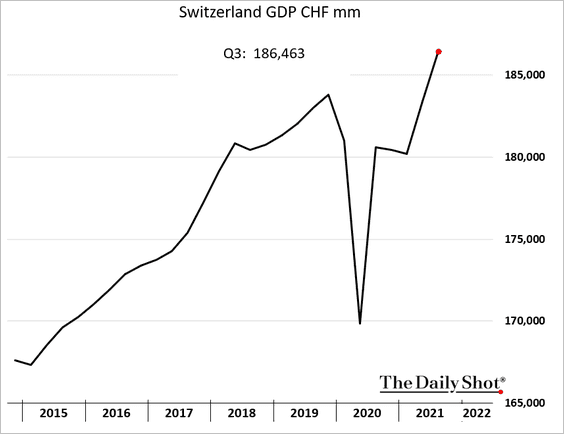
Swiss inflation is grinding higher.
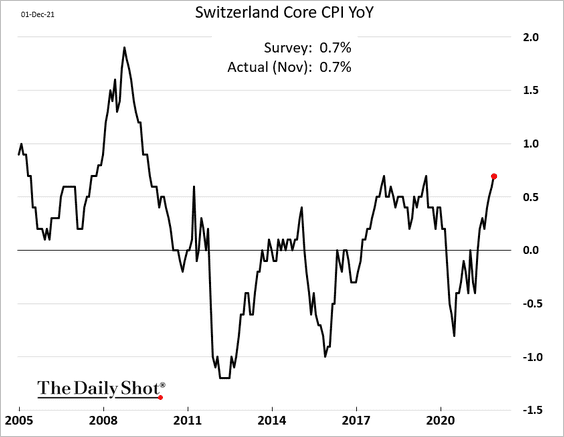
——————–
2. Here are the COVID measures across Western and Central Europe.
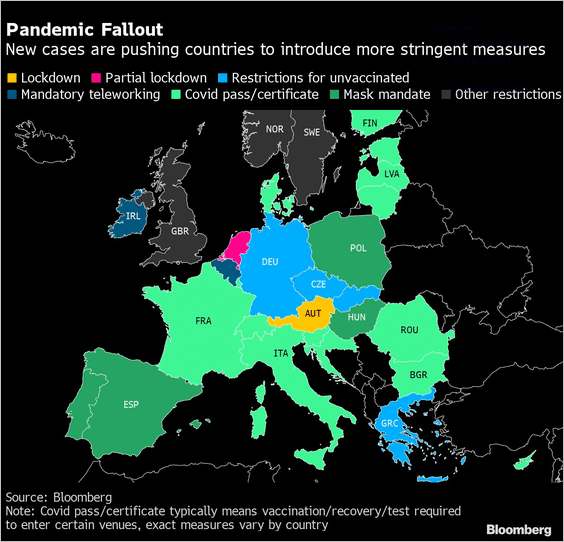 Source: @StuartLWallace, @CraigStirling Read full article
Source: @StuartLWallace, @CraigStirling Read full article
3. Central and Eastern European local bonds have underperformed since late September as inflation surges and central banks hike rates.
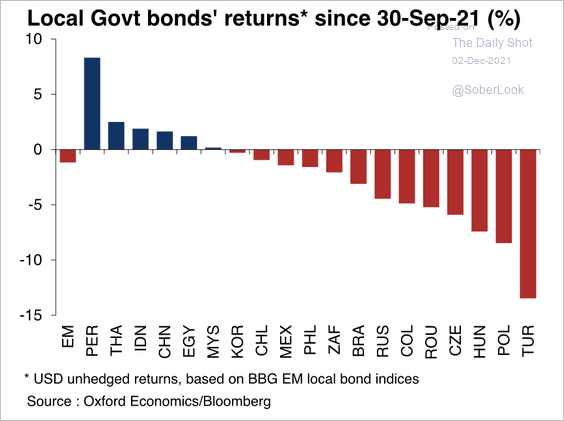 Source: Oxford Economics
Source: Oxford Economics
Here is Poland’s CPI, for example.
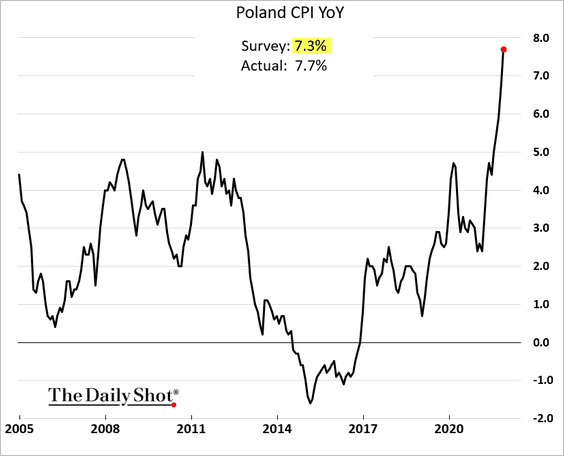
Back to Index
The United Kingdom
1. Home price appreciation held up well in November.
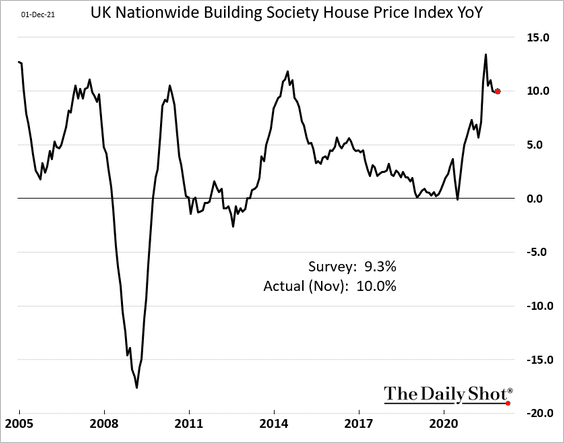
2. How much do you have to earn to be rich in the UK?
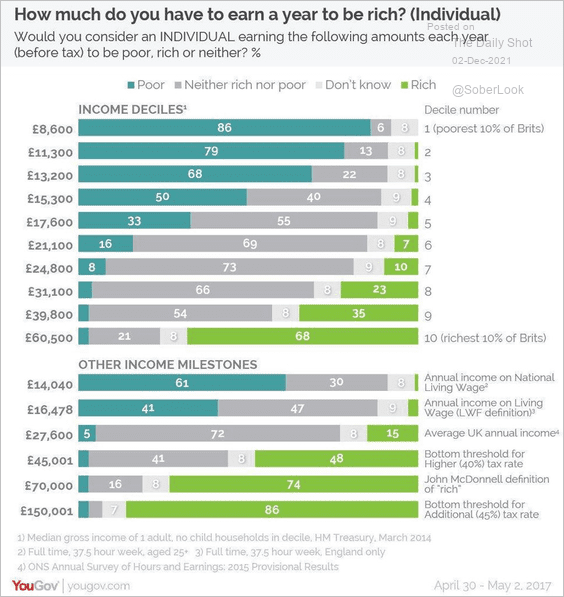 Source: YouGov Read full article
Source: YouGov Read full article
Back to Index
Canada
1. Manufacturing growth remains very strong.
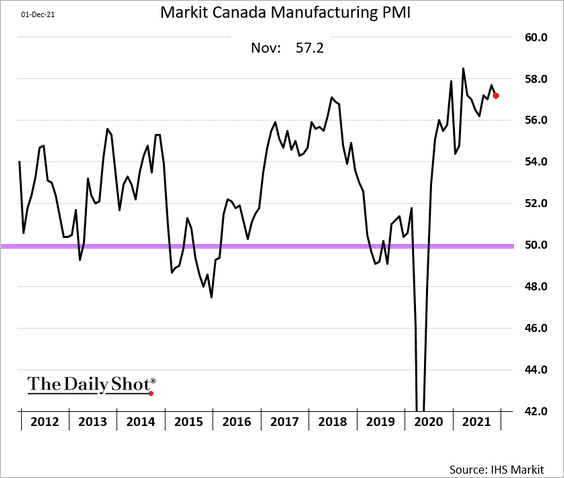
2. Building permits continue to trend higher.
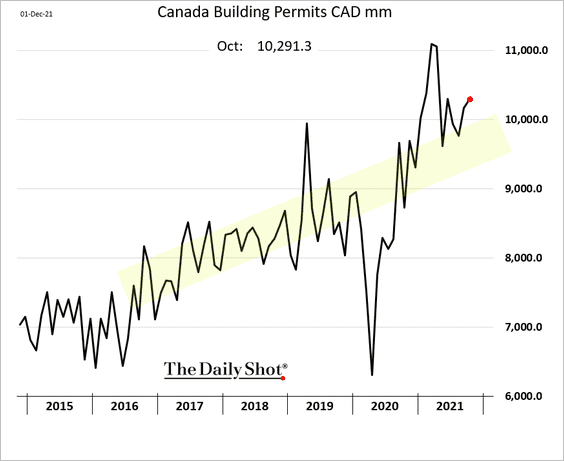
3. USD/CAD appears overvalued.
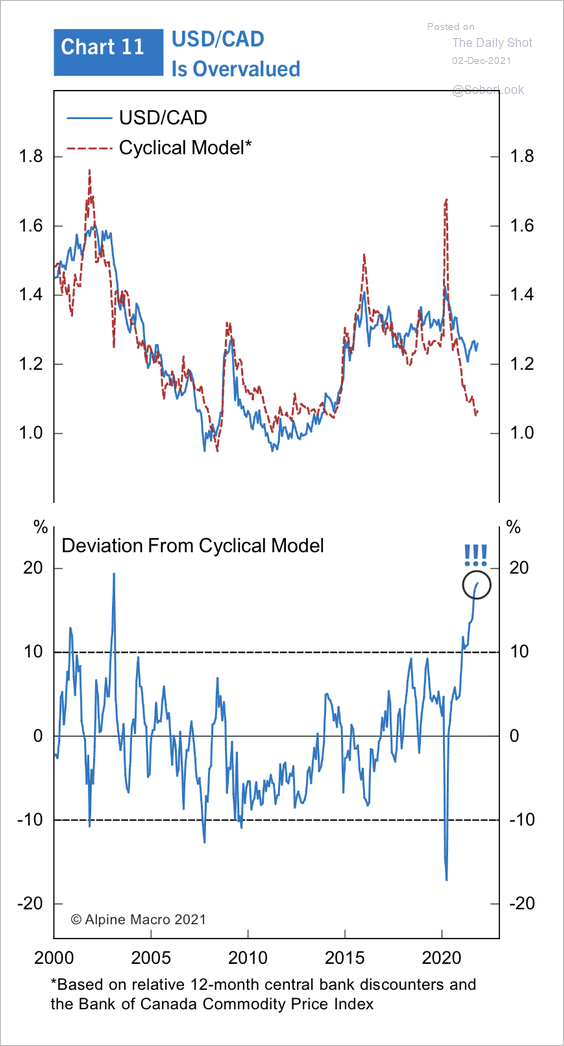 Source: Deutsche Bank Research
Source: Deutsche Bank Research
Back to Index
The United States
1. The Treasury curve continues to flatten.
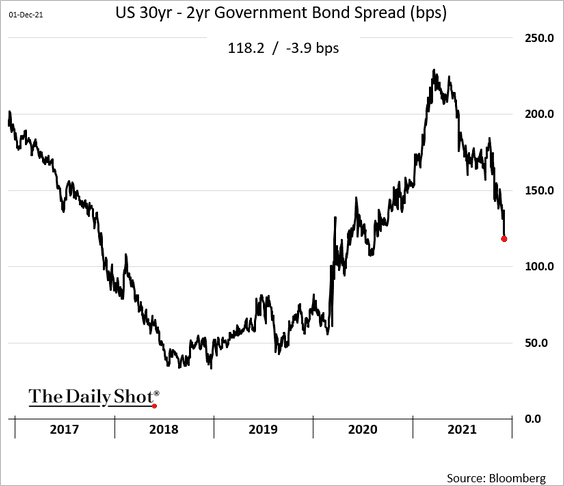
2. The ISM Manufacturing report was in line with expectations.
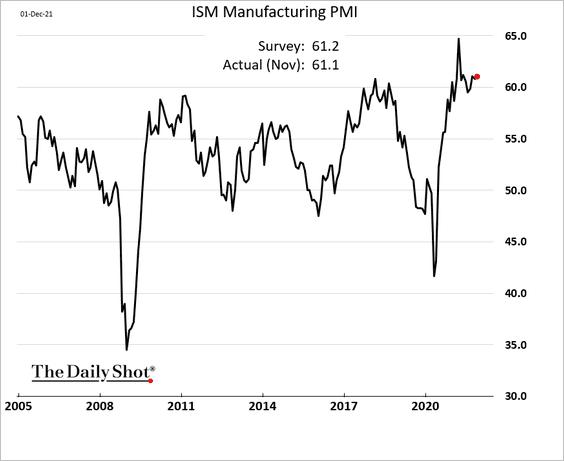
• Hiring picked up.
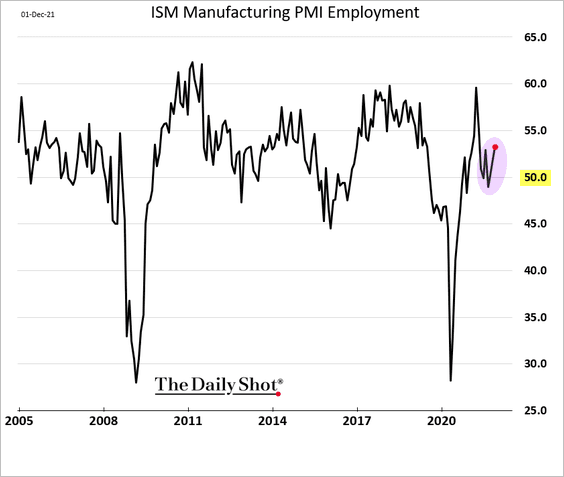
• Businesses continue to build inventories.
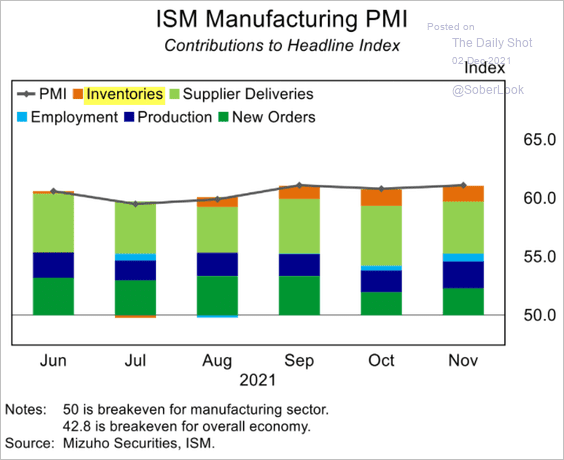 Source: Mizuho Securities USA
Source: Mizuho Securities USA
• The index measuring input prices surprised to the downside.
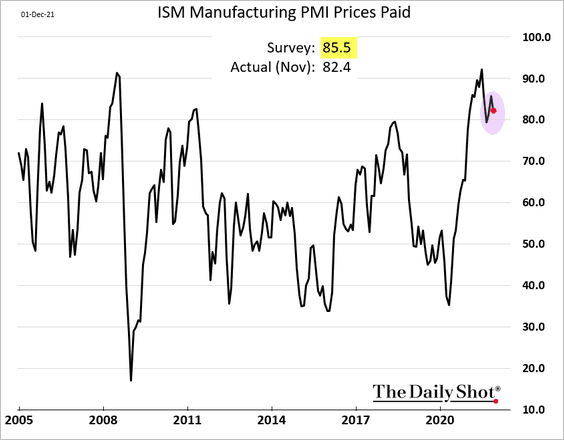
There are signs that supply-chain bottlenecks are starting to ease.
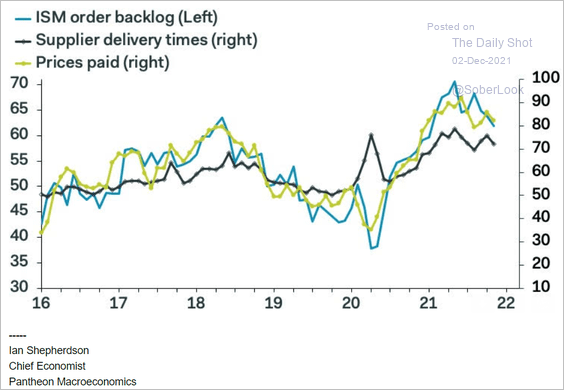 Source: Pantheon Macroeconomics
Source: Pantheon Macroeconomics
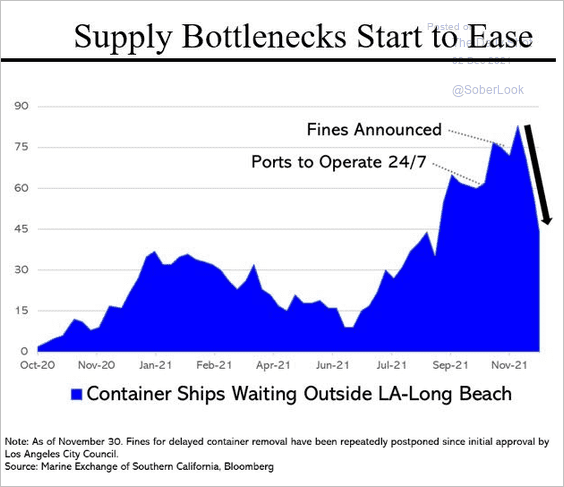 Source: @SteveRattner
Source: @SteveRattner
 Source: Reuters Read full article
Source: Reuters Read full article
——————–
3. The ADP employment report showed over half a million new private-sector jobs created in November.
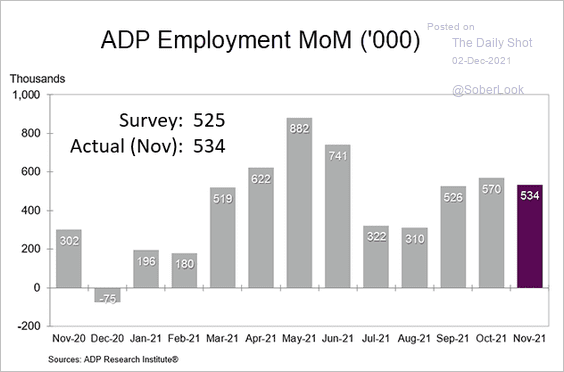 Source: ADP Research Institute
Source: ADP Research Institute
Once again, hiring was broad, with all major sectors showing gains.
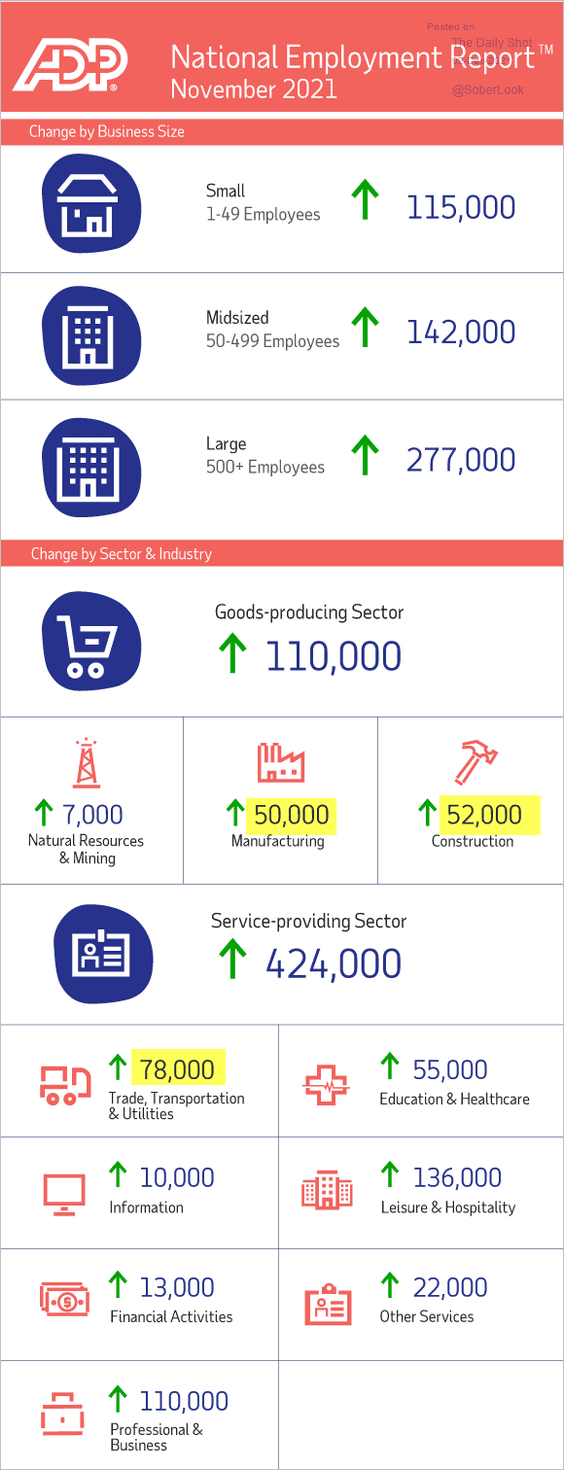 Source: ADP Research Institute
Source: ADP Research Institute
——————–
4. Residential and nonresidential construction spending trends continue to diverge.
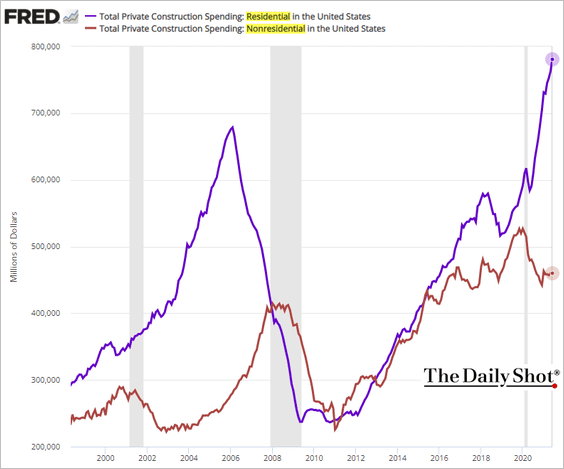
5. The Atalanta Fed’s GDPNow estimate for the fourth-quarter GDP growth is nearing 10% (annualized).
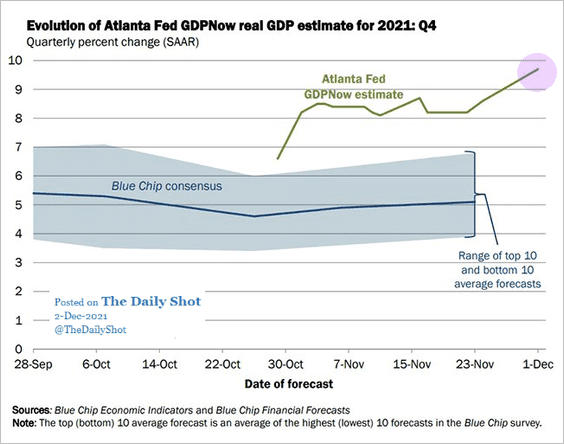 Source: @AtlantaFed
Source: @AtlantaFed
6. The Fed’s Beige Book continues to show supply chain challenges, although the number of comments related to “shortages” declined.
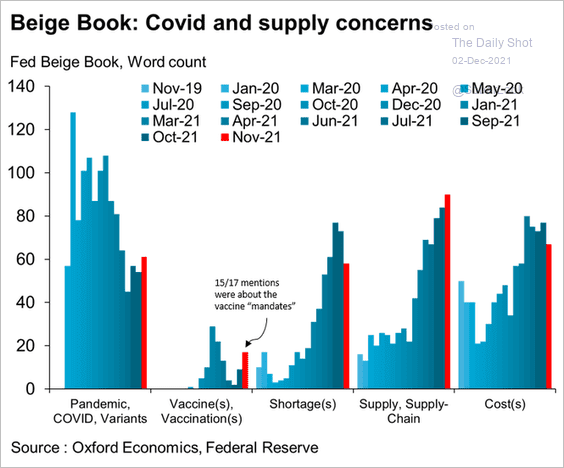 Source: @GregDaco
Source: @GregDaco
7. US November vehicle sales surprised to the downside.
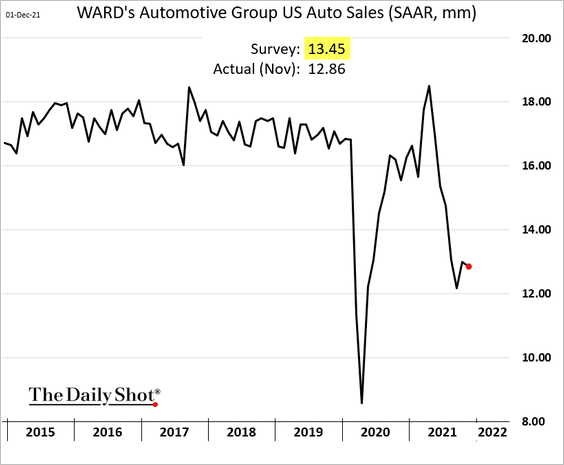
8. Thanksgiving week retail sales were disappointing relative to last year.
 Source: Statista
Source: Statista
Retail stocks have underperformed over the past few days (partially related to omicron).
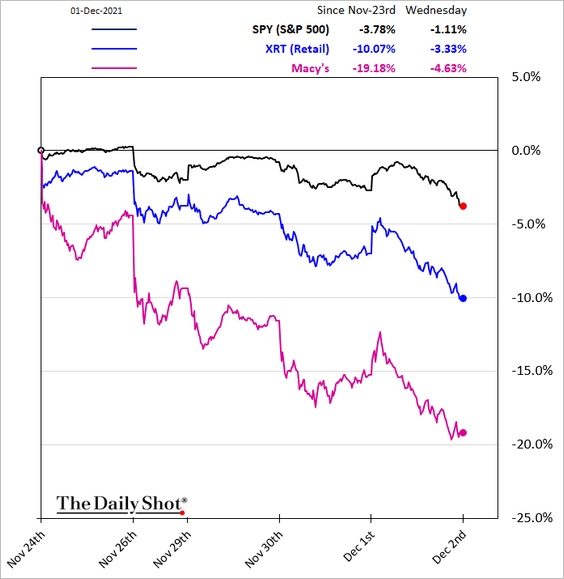
9. Finally, here is a survey from Evercore ISI on Christmas tree sales.
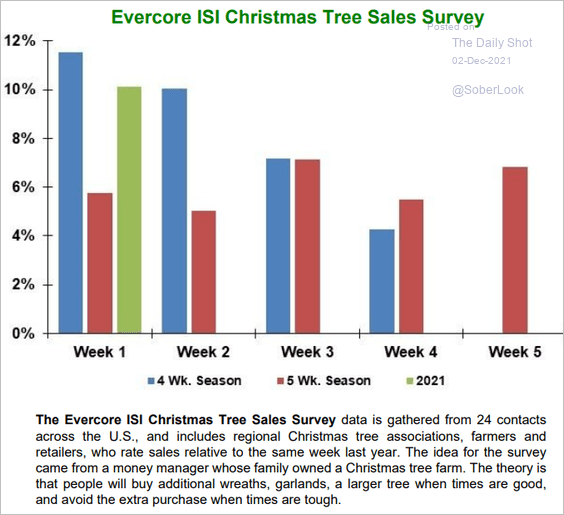 Source: Evercore ISI
Source: Evercore ISI
Back to Index
Global Developments
1. The dollar appears overbought in the short-term, while bullish positioning is near an extreme.
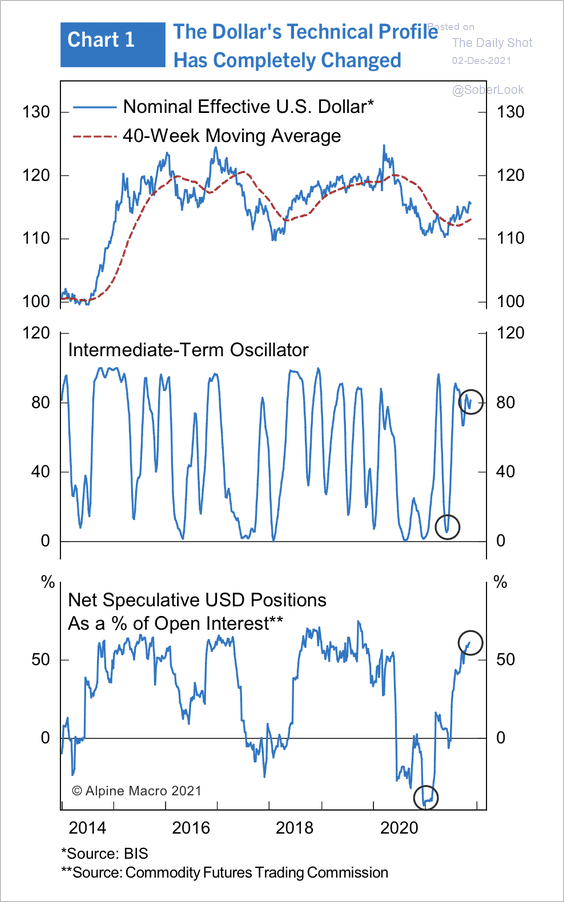 Source: Alpine Macro
Source: Alpine Macro
So far, yield differentials and a slowdown in China have supported dollar strength (2 charts).
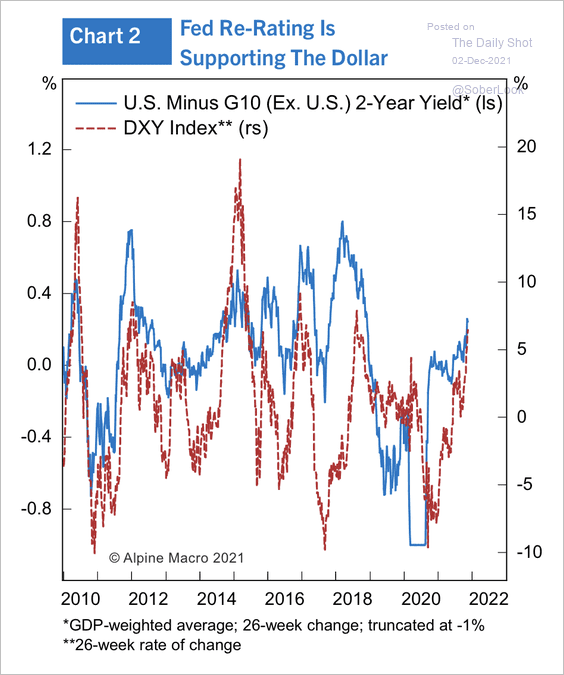 Source: Alpine Macro
Source: Alpine Macro
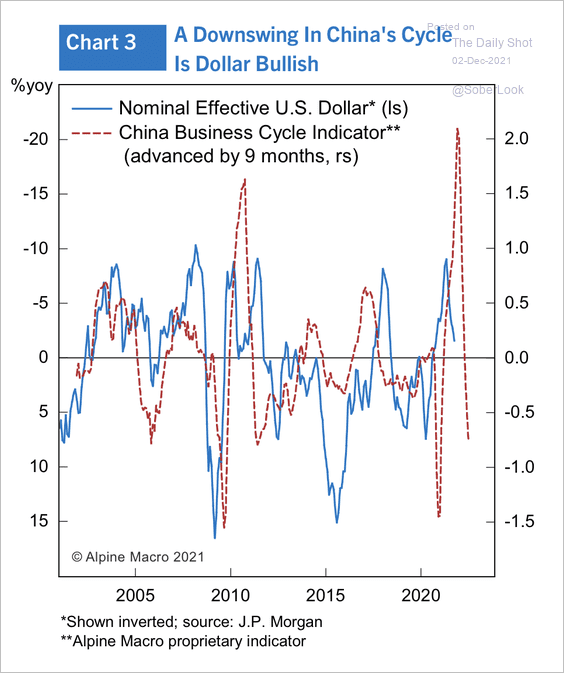 Source: Alpine Macro
Source: Alpine Macro
——————–
2. Declining market breadth implies wide divergences across asset class returns. This could signal a risk-off environment.
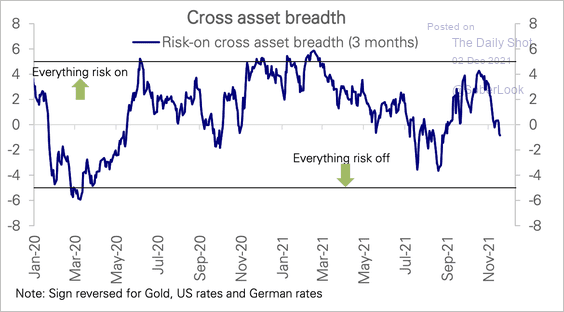 Source: Deutsche Bank Research
Source: Deutsche Bank Research
This chart shows the recent momentum dispersion across asset classes.
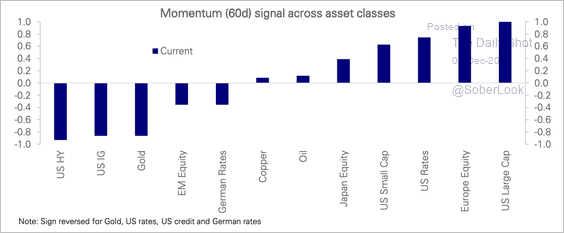 Source: Deutsche Bank Research
Source: Deutsche Bank Research
——————–
3. Here is the average deviation from central banks’ inflation targets.
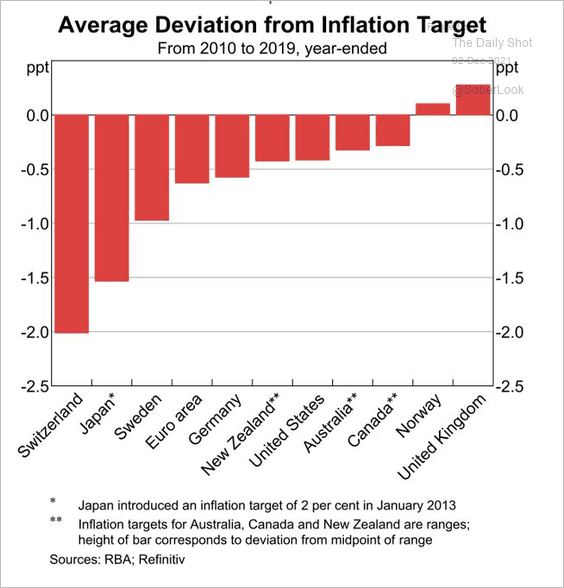 Source: @acemaxx, @BIS_org Read full article
Source: @acemaxx, @BIS_org Read full article
4. Finally, we have public and private sector debt over time for select economies.
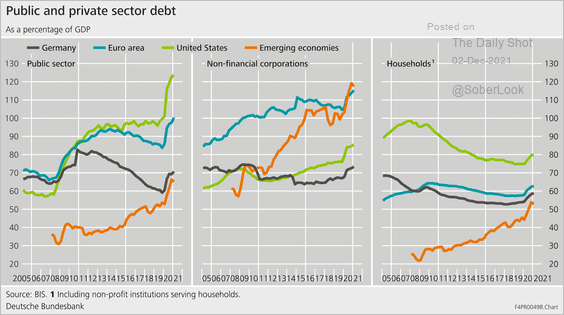 Source: Bundesbank Read full article
Source: Bundesbank Read full article
——————–
Food for Thought
1. A minute on the internet:
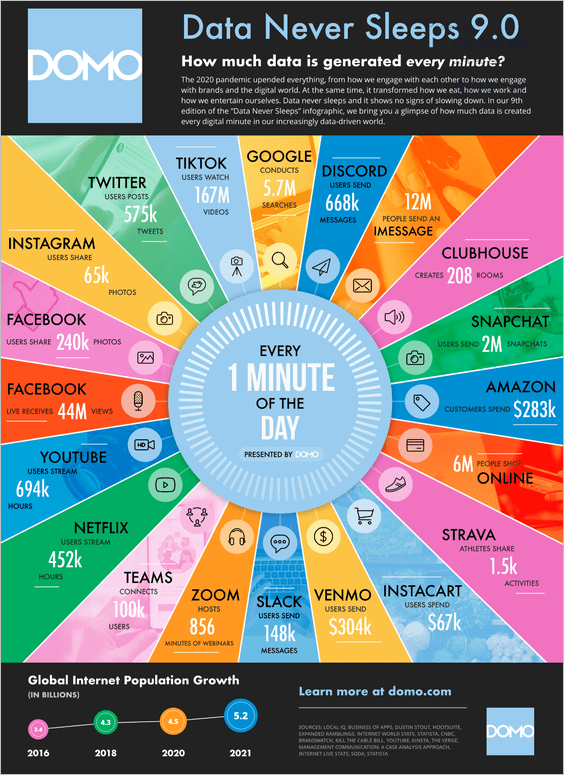 Source: Visual Capitalist Read full article
Source: Visual Capitalist Read full article
2. GoDaddy annual revenue:
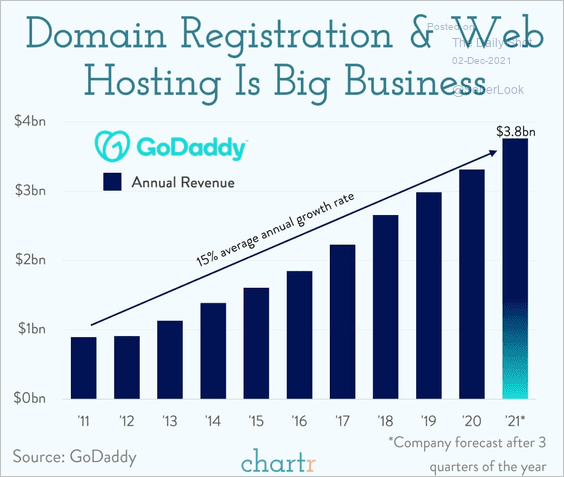 Source: @chartrdaily
Source: @chartrdaily
3. US video game players:
 Source: Statista
Source: Statista
4. Views on local schools balancing health with other priorities:
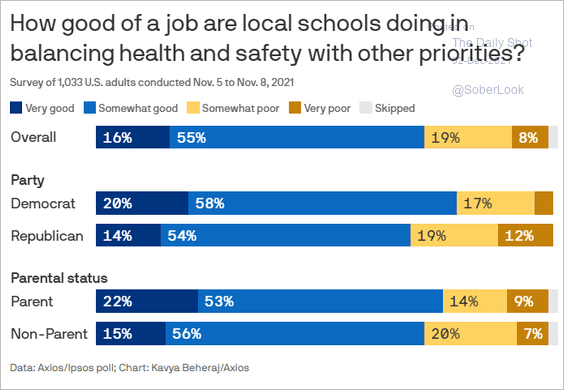 Source: @axios Read full article
Source: @axios Read full article
5. Transport energy usage per capita vs. population density:
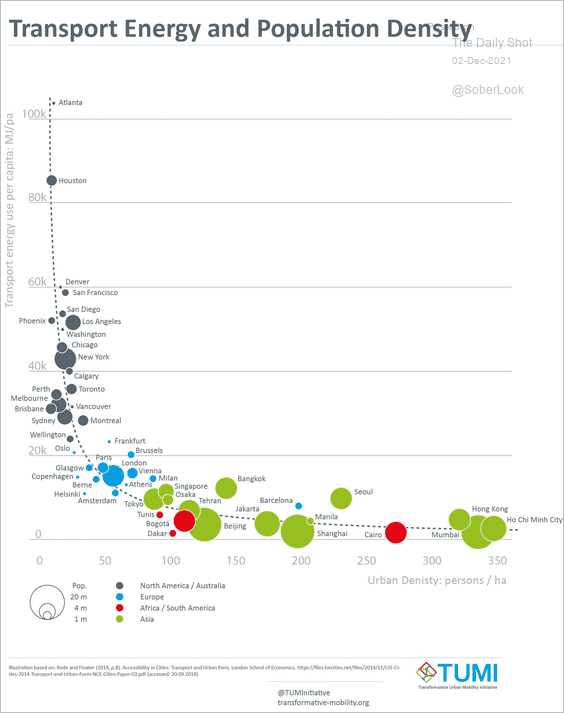 Source: @TUMInitiative
Source: @TUMInitiative
6. Vaccine production ramping up:
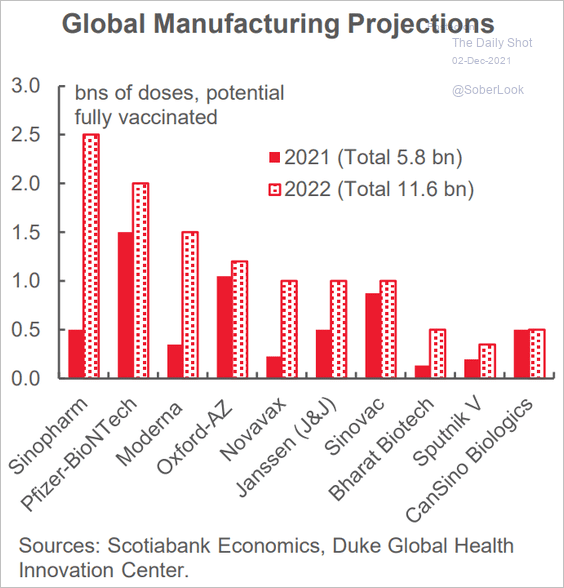 Source: Scotiabank Economics
Source: Scotiabank Economics
7. Omicron cases:
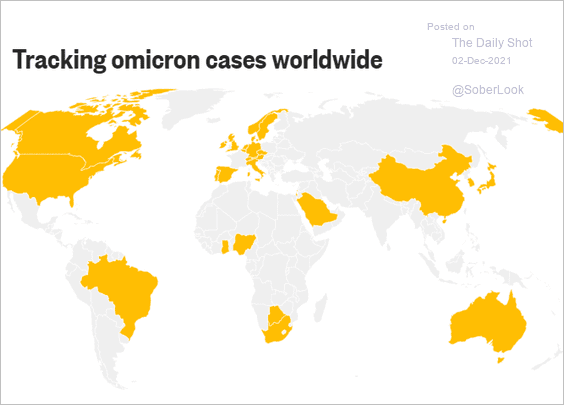 Source: NBC News Read full article
Source: NBC News Read full article
8. US population growth:
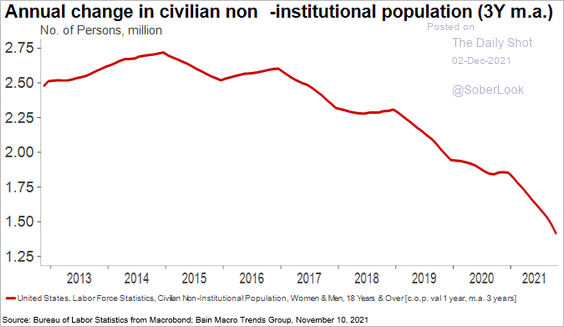 Source: Bain & Company Read full article
Source: Bain & Company Read full article
9. Wikipedia editors:

——————–
Back to Index
